Paper Menu >>
Journal Menu >>
 Journal of Modern Physics, 2013, 4, 70-93 http://dx.doi.org/10.4236/jmp.2013.44A010 Published Online April 2013 (http://www.scirp.org/journal/jmp) Predicting the Binding Energies of the 1s Nuclides with High Precision, Based on Baryons which Are Yang-Mills Magnetic Monopoles Jay R. Yablon Schenectady, New York, USA Email: jyablon@nycap.rr.com Received March 22, 2013; revised April 24, 2013; accepted April 29, 2013 Copyright © 2013 Jay R. Yablon. This is an open access article distributed under the Creative Commons Attribution License, which permits unrestricted use, distribution, and reproduction in any medium, provided the original work is properly cited. ABSTRACT In an earlier paper, the author employed the thesis that baryons are Yang-Mills magnetic monopoles and that proton and neutron binding energies are determined based on their up and down current quark masses to predict a relationship among the electron and up and down quark masses within experimental errors and to obtain a very accurate relationship for nuclear binding energies generally and for the binding of 56Fe in particular. The free proton and neutron were under- stood to each contain intrinsic binding energies which confine their quarks, wherein some or most (never all) of this energy is released for binding when they are fused into composite nuclides. The purpose of this paper is to further ad- vance this thesis by seeing whether it can explain the specific empirical binding energies of the light 1s nuclides, namely, 2H, 3H, 3He and 4He, with high precision. As the method to achieve this, we show how these 1s binding ener- gies are in fact the components of inner and outer tensor products of Yang-Mills matrices which are implicit in the ex- pressions for these intrinsic binding energies. The result is that the binding energies for the 4He, 3He and 3H nucleons are respectively, independently, explained to less than four parts in one million, four parts in 100,000, and seven parts in one million, all in AMU. Further, we are able to exactly relate the neutron minus proton mass difference to a function of the up and down current quark masses, which in turn enables us to explain the 2H binding energy most precisely of all, to just over 8 parts in ten million. These energies have never before been theoretically explained with such accuracy, which leads to the conclusion that the underlying thesis provides the strongest theoretical explanation to date of what baryons are, and of how protons and neutrons confine their quarks and bind together into composite nuclides. As is also reviewed in Section 9, these results may lay the foundation for more easily catalyzing nuclear fusion energy release. Keywords: Nuclides; Binding Energy; Deuteron; Triton; Helion; Alpha; Alpha Decay; Beta Decay; Yang-Mills; Magnetic Monopoles; Solar Fusion; Nuclear Fusion; Confinement 1. Introduction: Summary Review of the Thesis that Baryons Are Yang-Mills Magnetic Monopoles with Binding Energies Based on Their Current Quark Masses In an earlier paper [1], the author developed the thesis that magnetic monopole densities which come into exis- tence in a non-Abelian Yang-Mills gauge theory of non-commuting vector gauge boson fielG ds are synonymous with baryon densities. That is, baryons, in- cluding the protons and neutrons which form the vast preponderance of matter in the universe, are Yang-Mills magnetic monopoles. Conversely, magnetic monopoles, long pursued since the time of Maxwell, have always been hiding in plain sight, in Yang-Mills incarnation, as baryons, and especially, as protons and neutrons. Maxwell’s equations themselves provide the theoreti- cal foundation for this thesis, because if one starts with the classical electric charge and magnetic monopole field equations (respectively, (2.1) and (2.2) of [1]): [] JF DG g DDG PFFF (1.1) (1.2) DiG and combines the magnetic charge Equation (1.2) with a Yang-Mills (non-Abelian) field strength tensor is an N × N ma- which, like G F C opyright © 2013 SciRes. JMP 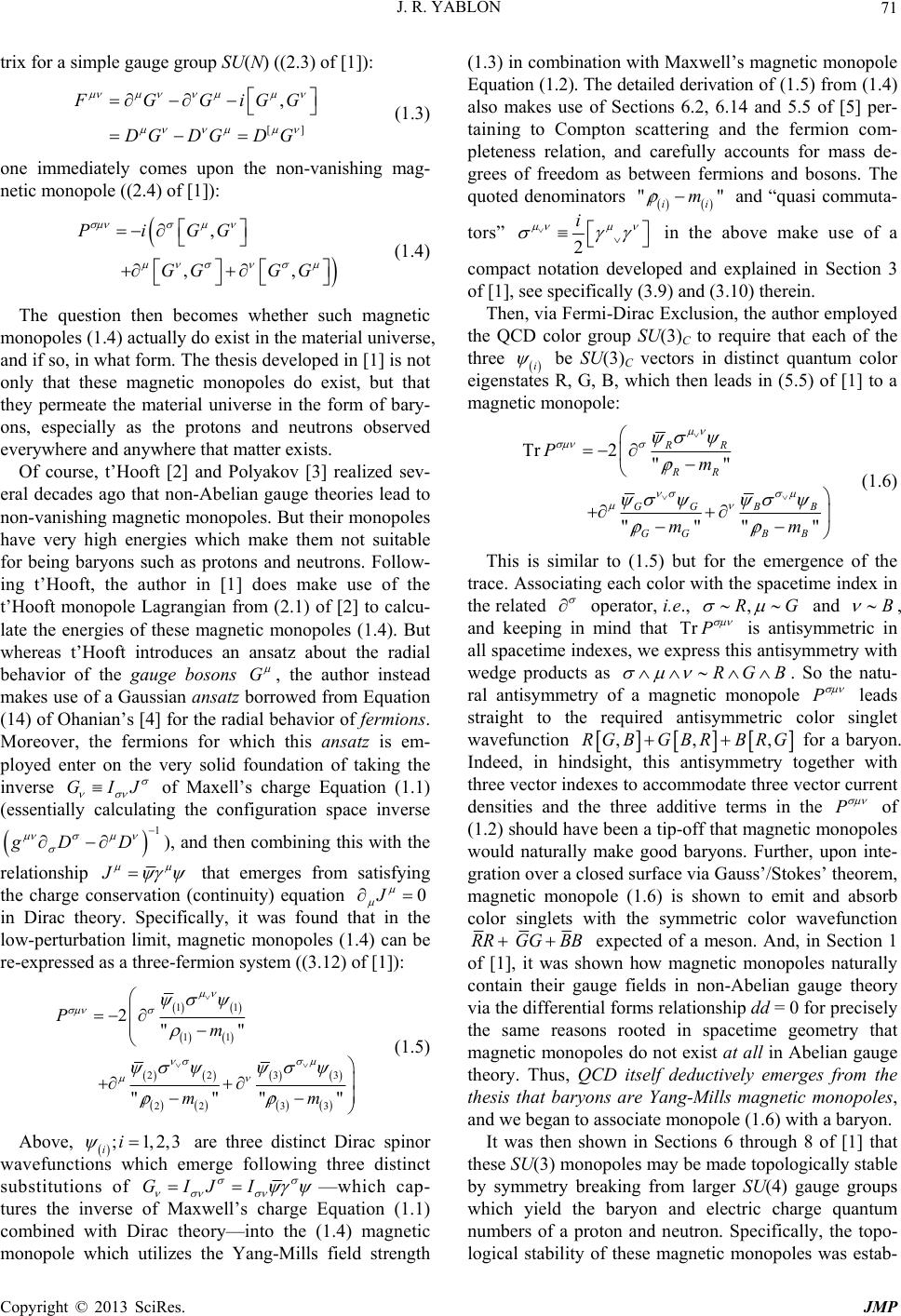 J. R. YABLON 71 trix for a simple gauge group SU(N) ((2.3) of [1]): [] , F GG DG DG iGG D G ,, G GG G (1.3) one immediately comes upon the non-vanishing mag- netic monopole ((2.4) of [1]): ,PiG GG (1.4) The question then becomes whether such magnetic monopoles (1.4) actually do exist in the material universe, and if so, in what form. The thesis developed in [1] is not only that these magnetic monopoles do exist, but that they permeate the material universe in the form of bary- ons, especially as the protons and neutrons observed everywhere and anywhere that matter exists. Of course, t’Hooft [2] and Polyakov [3] realized sev- eral decades ago that non-Abelian gauge theories lead to non-vanishing magnetic monopoles. But their monopoles have very high energies which make them not suitable for being baryons such as protons and neutrons. Follow- ing t’Hooft, the author in [1] does make use of the t’Hooft monopole Lagrangian from (2.1) of [2] to calcu- late the energies of these magnetic monopoles (1.4). But whereas t’Hooft introduces an ansatz about the radial behavior of the gauge bosons , the author instead makes use of a Gaussian ansatz borrowed from Equation (14) of Ohanian’s [4] for the radial behavior of fermions. Moreover, the fermions for which this ansatz is em- ployed enter on the very solid foundation of taking the inverse GIJ of Maxell’s charge Equation (1.1) (essentially calculating the configuration space inverse 1 D gD ), and then combining this with the relationship J 0J that emerges from satisfying the charge conservation (continuity) equation in Dirac theory. Specifically, it was found that in the low-perturbation limit, magnetic monopoles (1.4) can be re-expressed as a three-fermion system ((3.12) of [1]): 11 11 22 22 2"" "" Pm 33 33 ""mm (1.5) Above, i;1,2,3i are three distinct Dirac spinor wavefunctions which emerge following three distinct substitutions of GI J I "" ii m —which cap- tures the inverse of Maxwell’s charge Equation (1.1) combined with Dirac theory—into the (1.4) magnetic monopole which utilizes the Yang-Mills field strength (1.3) in combination with Maxwell’s magnetic monopole Equation (1.2). The detailed derivation of (1.5) from (1.4) also makes use of Sections 6.2, 6.14 and 5.5 of [5] per- taining to Compton scattering and the fermion com- pleteness relation, and carefully accounts for mass de- grees of freedom as between fermions and bosons. The quoted denominators and “quasi commuta- tors” 2 i in the above make use of a compact notation developed and explained in Section 3 of [1], see specifically (3.9) and (3.10) therein. Then, via Fermi-Dirac Exclusion, the author employed the QCD color group SU (3)C to require that each of the three i be SU(3 )C vectors in distinct quantum color eigenstates R, G, B, which then leads in (5.5) of [1] to a magnetic monopole: Tr2 "" """" RR RR GG BB GG BB Pm mm (1.6) This is similar to (1.5) but for the emergence of the trace. Associating each color with the spacetime index in the related operator, i.e., ,RG B and , and keeping in mind that Tr P RGB is antisymmetric in all spacetime indexes, we express this antisymmetry with wedge products as P . So the natu- ral antisymmetry of a magnetic monopole leads straight to the required antisymmetric color singlet wavefunction ,,,RGB GBRBRG P for a baryon. Indeed, in hindsight, this antisymmetry together with three vector indexes to accommodate three vector current densities and the three additive terms in the of (1.2) should have been a tip-off that magnetic monopoles would naturally make good baryons. Further, upon inte- gration over a closed surface via Gauss’/Stokes’ theorem, magnetic monopole (1.6) is shown to emit and absorb color singlets with the symmetric color wavefunction RR GG BB logical stability of these magnetic monopoles was estab- expected of a meson. And, in Section 1 of [1], it was shown how magnetic monopoles naturally contain their gauge fields in non-Abelian gauge theory via the differential forms relationship dd = 0 for precisely the same reasons rooted in spacetime geometry that magnetic monopoles do not exist at all in Abelian gauge theory. Thus, QCD itself deductively emerges from the thesis that baryons are Yang-Mills magnetic monopoles, and we began to associate monopole (1.6) with a baryon. It was then shown in Sections 6 through 8 of [1] that these SU(3) monopoles may be made topologically stable by symmetry breaking from larger SU(4) gauge groups which yield the baryon and electric charge quantum numbers of a proton and neutron. Specifically, the topo- Copyright © 2013 SciRes. JMP  J. R. YABLON 72 lished in Sections 6 and 8 of [1] based on Cheng and Li [6] at 472-473 and Weinberg [7] at 442. The proton and neutron are developed as particular types of magnetic monopole in Section 7 of [1] making use of SU(4) gauge groups for baryon minus lepton number BL based on Volovok’s [8], Section 12.2.2. The spons symme- try breaking of these SU(4) gauge groups is then fash- ioned on Georgi-Glashow’s SU(5) GUT model [9] re- viewed in detail in Section 8 of [1]. By then employing the earlier-r taneou eferenced “Gaussian ansatz” from Ohanian’s [4], namely ((9.9) of [1]): 2 31rr 0 24 2 πexp2 rup (1.7) for the radial behavior of the fermion wavefunctions, of [1], the author us ner together with the t’Hooft monopole Lagrangian from (2.1) of [2] (see (9.2) of [1]) it became possible to analytically calculate the energies of these Yang-Mills magnetic monopoles (1.6) following their development into topo- logically stable protons and neutrons. Specifically, in Sections 11 and 12 ed the pure gauge field terms gauge L of the t’Hooft monopole Lagrangian to specify the egy of the Yang- Mills magnetic monopoles, exclusive of the vacuum , via (11.7) of [1]: 3 gauge 1 dT 2 Ex L3 r d FFx . (1.8) We then made use in (1.8) of field strength tensors for protons and neutrons developed via Gauss’/Stokes’ the- orem from (1.6) in (11.3) and (11.4) of [1], respectively: P Tr 2 "" dd dd "" uu uu imm (1.9) F N Tr 2 "" uu uu F im " " dd dd m (1.10) u where and d are Dirac wavefunctions for up and uar de ectron mass is down qks, toduce three relationships which yielded remarkable concurrence with empirical data. First, we found in (11.22) of [1] that the el related to up and down quark masses according to: 3 2 2π u m, (1.11) whervisor 0.510998928 MeV3 ed mm e the di 3 2 2π results as a natural conse- dimenquence of the three-sional integration (1.8) when the Gaussian ansatz for fermions is specified as in (1.7), and where the wavelengths in (1.7) are taken to be re- lated to the quark masses via the de Broglie relation mc . aSecondnd third, we found in (12.12) and (12.13) of [1] that if one postulates the current mass of the up quark to be equal to the deuteron (2H nucleus) binding energy based on 1) empirical concurrence within experimental errors and 2) regarding nucleons to be resonant cavities with binding energies determined in relation to their up and down current quark masses, then the proton and neu- tron each possess respective intrinsic, latent binding en- ergies B (i.e., energies intrinsically available for nuclear binding): 3 2 P B244 2π 7.640679 MeV ud dudu mm mmmm (1.12) 3 2 N B244 2π 9.812358 MeV du uudd mm mmmm (1.13) So for a nucleus with an equal number of protons and neutrons, the average binding energy per nucleon is pre- dicted to be 8.726519 MeV. Not only does this explain why a typical nucleus beyond the very lightest (which we shall be studying in detail here) has a binding energy in exactly this vicinity (see Figure 1 below), but when this is applied to 56Fe with 26 protons and 30 neutrons— which has the distinction of using a higher percentage of this available binding energy than any other nuclide—we see that the latent available binding energy is predicted to be ((12.14) of [1]): 56 B Fe267.640679 MeV 309.812358 MeV 493.028394 MeV (1.14) This contrasts remarkably with the observed 56Fe bi resonant ca nding energy of 492.253892 MeV. That is, precisely 99.8429093% of the available binding energy predicted by this model of nucleons as Yang-Mills magnetic mono- poles goes into binding together the 56Fe nucleus, with a small 0.1570907% balance reserved for confining quarks within each nucleon. This means while quarks are very much freer in the nucleons of 56Fe than in free nucleons (which also appears to explain the “first EMC effect” [10]), their confinement is never fully overcome. Con- finement bends but never breaks. Quarks step back from the brink of becoming de-confined in 56Fe as one moves to even heavier nuclides, and remain confined no matter what the nuclide. Iron-56 thus sits at the theoretical crossroads of fission, fusion and confinement. This thesis that protons and neutrons are vities which emit and absorb energies that directly manifest their current quark masses will be central to the Copyright © 2013 SciRes. JMP 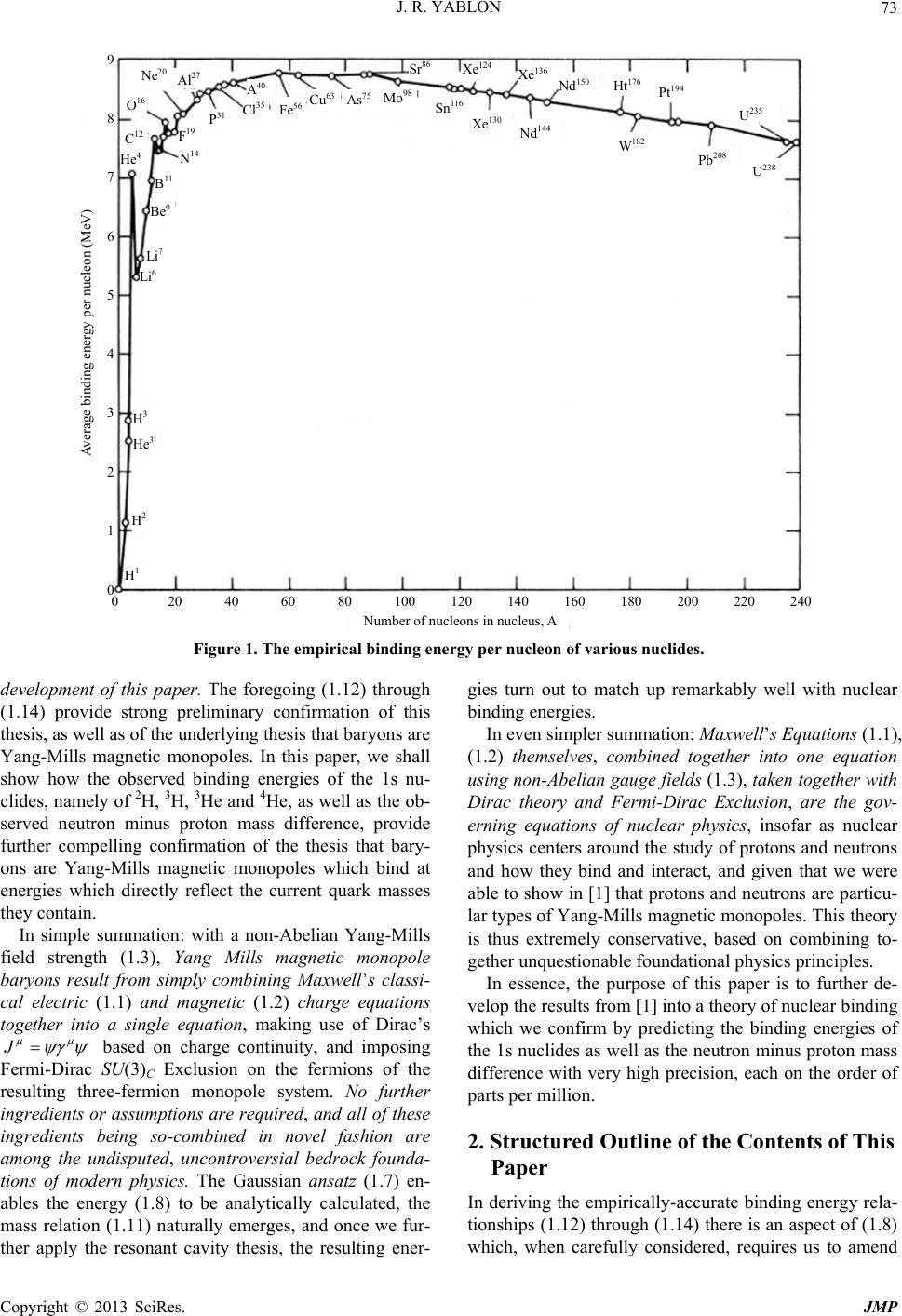 J. R. YABLON Copyright © 2013 SciRes. JMP 73 N e 20 0 20 40 60 80 100 120 140 160 180 200 220 240 9 Number of nucleons in nucleus , A 8 7 6 5 4 3 2 1 0 Average binding energy per nucleon (MeV) Li 6 Li 7 H 1 H 2 He 3 H 3 He 4 Be 9 B 11 N 14 F 19 P 31 C 12 O 16 Al 27 Cl 35 A 40 Fe 56 Cu 63 As 75 Mo 98 Xe 130 N d 144 W 182 Sn 116 Pb 208 U 238 U 235 Pt 194 Ht 176 N d 150 Xe 136 Xe 124 Sr 86 Figure 1. The empirical binding ener gy per nuc leon of various nuclides. evelopment of this paper. The foregoing (1.12) through ummation: with a non-Abelian Yang-Mills fie d (1.14) provide strong preliminary confirmation of this thesis, as well as of the underlying thesis that baryons are Yang-Mills magnetic monopoles. In this paper, we shall show how the observed binding energies of the 1s nu- clides, namely of 2H, 3H, 3He and 4He, as well as the ob- served neutron minus proton mass difference, provide further compelling confirmation of the thesis that bary- ons are Yang-Mills magnetic monopoles which bind at energies which directly reflect the current quark masses they contain. In simple s ld strength (1.3), Yang Mills magnetic monopole baryons result from simply combining Maxwell’s classi- cal electric (1.1) and magnetic (1.2) charge equations together into a single equation, making use of Dirac’s J based on charge continuity, and imposing SU(3)C Exclusion on the fermions of the resulting three-fermion monopole system. No further ingredients or assumptions are required, and all of these ingredients being so-combined in novel fashion are among the undisputed, uncontroversial bedrock founda- tions of modern physics. The Gaussian ansatz (1.7) en- ables the energy (1.8) to be analytically calculated, the mass relation (1.11) naturally emerges, and once we fur- ther apply the resonant cavity thesis, the resulting ener- binding energies. In even simpler summation: Maxwell’s Equations (1.1), (1.2) themselves, Fermi-Dirac gies turn out to match up remarkably well with nuclear combined together into one equation us g w utline of the Contents of This tio .12) through (1.14) there is an aspect of (1.8) ing non-Abelian gauge fields (1.3), taken together with Dirac theory and Fermi-Dirac Exclusion, are the gov- erning equations of nuclear physics, insofar as nuclear physics centers around the study of protons and neutrons and how they bind and interact, and given that we were able to show in [1] that protons and neutrons are particu- lar types of Yang-Mills magnetic monopoles. This theory is thus extremely conservative, based on combining to- gether unquestionable foundational physics principles. In essence, the purpose of this paper is to further de- velop the results from [1] into a theory of nuclear bindin hich we confirm by predicting the binding energies of the 1s nuclides as well as the neutron minus proton mass difference with very high precision, each on the order of parts per million. 2. Structured O Paper In deriving the empirically-accurate binding energy rela- nships (1 which, when carefully considered, requires us to amend 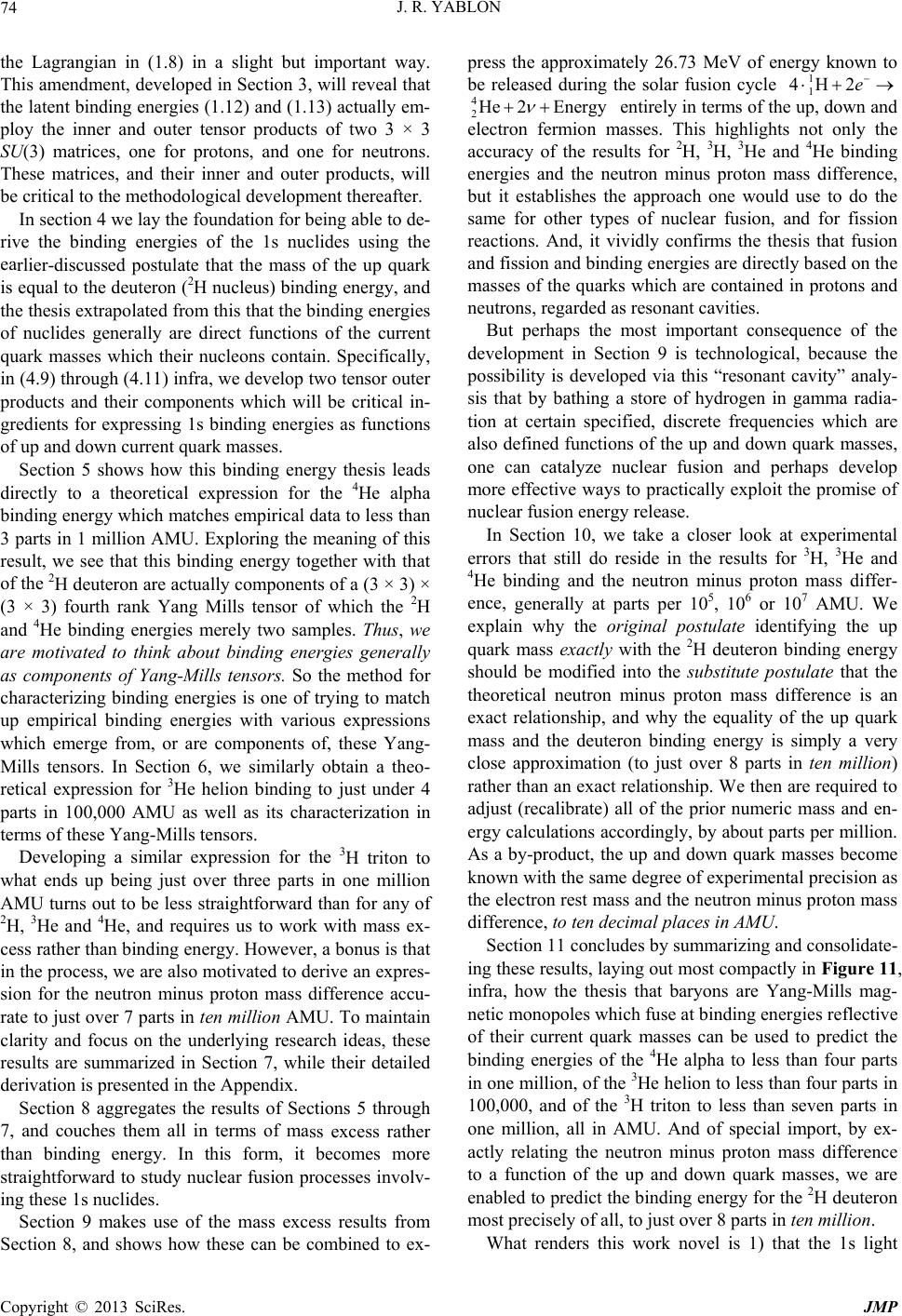 J. R. YABLON 74 the Lagrangian in (1.8) in a slight but important way. This amendment, developed in Section 3, will reveal that the latent binding energies (1.12) and (1.13) actually em- ploy the inner and outer tensor products of two 3 × 3 SU(3) matrices, one for protons, and one for neutrons. These matrices, and their inner and outer products, will be critical to the methodological development thereafter. In section 4 we lay the foundation for being able to de- rive the binding energies of the 1s nuclides using the ea or the 4He alpha bi parts in one million A ss excess rather th how these can be combined to ex- pr not only the accuracy of the re ical, because the po e results for 3H, 3He and 4H y in Figure 11, in rlier-discussed postulate that the mass of the up quark is equal to the deuteron (2H nucleus) binding energy, and the thesis extrapolated from this that the binding energies of nuclides generally are direct functions of the current quark masses which their nucleons contain. Specifically, in (4.9) through (4.11) infra, we develop two tensor outer products and their components which will be critical in- gredients for expressing 1s binding energies as functions of up and down current quark masses. Section 5 shows how this binding energy thesis leads directly to a theoretical expression f nding energy which matches empirical data to less than 3 parts in 1 million AMU. Exploring the meaning of this result, we see that this binding energy together with that of the 2H deuteron are actually components of a (3 × 3) × (3 × 3) fourth rank Yang Mills tensor of which the 2H and 4He binding energies merely two samples. Thus, we are motivated to think about binding energies generally as components of Yang-Mills tensors. So the method for characterizing binding energies is one of trying to match up empirical binding energies with various expressions which emerge from, or are components of, these Yang- Mills tensors. In Section 6, we similarly obtain a theo- retical expression for 3He helion binding to just under 4 parts in 100,000 AMU as well as its characterization in terms of these Yang-Mills tensors. Developing a similar expression for the 3H triton to what ends up being just over three MU turns out to be less straightforward than for any of 2H, 3He and 4He, and requires us to work with mass ex- cess rather than binding energy. However, a bonus is that in the process, we are also motivated to derive an expres- sion for the neutron minus proton mass difference accu- rate to just over 7 parts in ten million AMU. To maintain clarity and focus on the underlying research ideas, these results are summarized in Section 7, while their detailed derivation is presented in the Appendix. Section 8 aggregates the results of Sections 5 through 7, and couches them all in terms of ma an binding energy. In this form, it becomes more straightforward to study nuclear fusion processes involv- ing these 1s nuclides. Section 9 makes use of the mass excess results from Section 8, and shows ess the approximately 26.73 MeV of energy known to be released during the solar fusion cycle 1 1 4H2e 4 2He 2Energy entirely in terms of the up, down and electron fermion masses. This highlights sults for 2H, 3H, 3He and 4He binding energies and the neutron minus proton mass difference, but it establishes the approach one would use to do the same for other types of nuclear fusion, and for fission reactions. And, it vividly confirms the thesis that fusion and fission and binding energies are directly based on the masses of the quarks which are contained in protons and neutrons, regarded as resonant cavities. But perhaps the most important consequence of the development in Section 9 is technolog ssibility is developed via this “resonant cavity” analy- sis that by bathing a store of hydrogen in gamma radia- tion at certain specified, discrete frequencies which are also defined functions of the up and down quark masses, one can catalyze nuclear fusion and perhaps develop more effective ways to practically exploit the promise of nuclear fusion energy release. In Section 10, we take a closer look at experimental errors that still do reside in th e binding and the neutron minus proton mass differ- ence, generally at parts per 105, 106 or 107 AMU. We explain why the original postulate identifying the up quark mass exactly with the 2H deuteron binding energy should be modified into the substitute postulate that the theoretical neutron minus proton mass difference is an exact relationship, and why the equality of the up quark mass and the deuteron binding energy is simply a very close approximation (to just over 8 parts in ten million) rather than an exact relationship. We then are required to adjust (recalibrate) all of the prior numeric mass and en- ergy calculations accordingly, by about parts per million. As a by-product, the up and down quark masses become known with the same degree of experimental precision as the electron rest mass and the neutron minus proton mass difference, to ten decimal places in AMU. Section 11 concludes by summarizing and consolidate- ing these results, laying out most compactl fra, how the thesis that baryons are Yang-Mills mag- netic monopoles which fuse at binding energies reflective of their current quark masses can be used to predict the binding energies of the 4He alpha to less than four parts in one million, of the 3He helion to less than four parts in 100,000, and of the 3H triton to less than seven parts in one million, all in AMU. And of special import, by ex- actly relating the neutron minus proton mass difference to a function of the up and down quark masses, we are enabled to predict the binding energy for the 2H deuteron most precisely of all, to just over 8 parts in ten million. What renders this work novel is 1) that the 1s light Copyright © 2013 SciRes. JMP 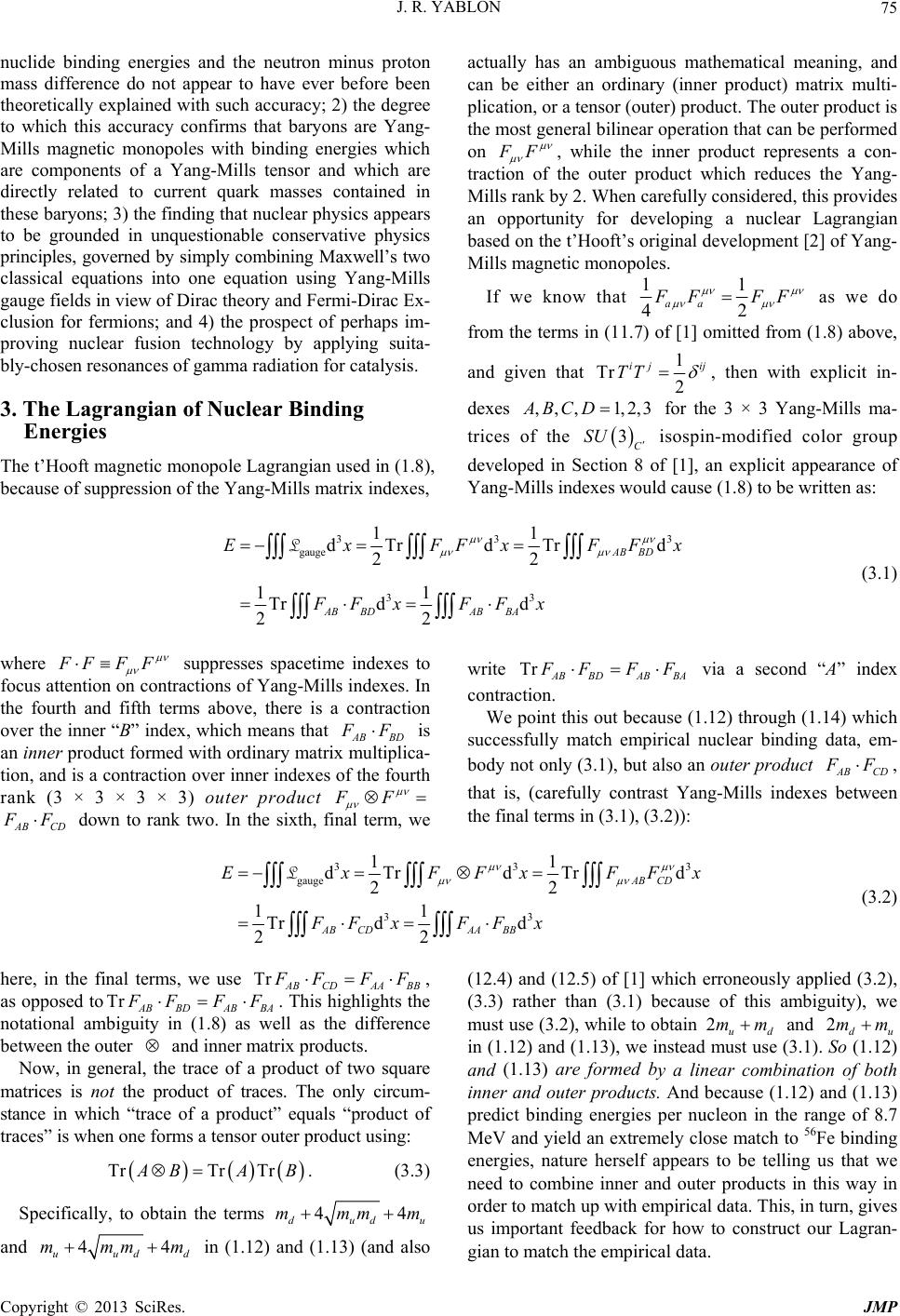 J. R. YABLON © 2013 SciRes. JMP 75 in (1.8), because of suppression of the Yang-Mills matrix indexes, nuclide binding energies and the neutron minus protonactually has an ambiguous mathematical meaning, and can be either an ordinary (inner product) matrix multi- plication, or a tensor (outer) product. The outer product is the most general bilinear operation that can be performed on mass difference do not appear to have ever before been theoretically explained with such accuracy; 2) the degree to which this accuracy confirms that baryons are Yang- Mills magnetic monopoles with binding energies which are components of a Yang-Mills tensor and which are directly related to current quark masses contained in these baryons; 3) the finding that nuclear physics appears to be grounded in unquestionable conservative physics principles, governed by simply combining Maxwell’s two classical equations into one equation using Yang-Mills gauge fields in view of Dirac theory and Fermi-Dirac Ex- clusion for fermions; and 4) the prospect of perhaps im- proving nuclear fusion technology by applying suita- bly-chosen resonances of gamma radiation for catalysis. 3. The Lagrangian of Nuclear Binding Energies F F , while the inner product represents a con- traction of the outer product which reduces the Yang- Mills rank by 2. When carefully considered, this provides an opportunity for developing a nuclear Lagrangian based on the t’Hooft’s original development [2] of Yang- Mills magnetic monopoles. Copyright The t’Hooft magnetic monopole Lagrangian used If we know that 11 42 aa F FFF as we do from the terms in (11.7) of [1] omitted from (1.8) above, and given that 1 2 ij ij TTTr ,,, 1,2,3ABCD , then with explicit in- dexes for the 3 × 3 Yang-Mills ma- 3C SU isospin-modified color group trices of the developed in Section 8 of [1], an explicit appearance of Yang-Mills indexes would cause (1.8) to be written as: 3 gauge 1 dTrExF L3 3 33 1 dTr d 22 11 Tr dd 22 AB BD AB BDAB BA FxFFx FFxFF x (3.1) where F FFF suppresses spacetime indexes to cus attention on contractions of Yang-Mills indexes. In rth and fifth te write TrAB BDAB BA F FFF via a second “A” index contraction. point this out because ( match empirical nuclear binding data, em- bo fo the fourms above, there is a contraction over the inner “B” index, which means that AB BD F F is an inn er product formed with ordinary matrix multiplica- tion, and is a contraction over inner indexes ofrth rank (3 × 3 × 3 × 3) outer product FF We 1.12) through (1.14) which successfully dy not only (3.1), but also an outer product AB CD F F, that is, (carefully contrast Yang-Mills indexes between the fou AB CD F F down to rank two. In the sixth, final term, we the final terms in (3.1), (3.2)): 3 gauge 1 dTrExF L33 1 dTr d AB CD FxFFx 33 22 11 Tr d d 22 AB CDAA BB FF xFF x (3.2) here, in the final terms, we use Tr AB CDAA BB F FFF, s opposed toTr aAB BDAB BA F FFF. This highlights the st notational ambiguity in (1.8) as well as the difference ter and inner matr ircum- between the ouix products. Now, in general, the trace of a product of two square matrices is not the product of traces. The only c ance in which “trace of a product” equals “product of traces” is when one forms a tensor outer product using: TrTr Tr A BAB . (3.3) Specifically, to obtain the terms 44 udu mmm d m and 44 uudd mmmm in (1.13) (and also (12.4) and (12.5) of [1] which erroneously applied (3.2), (3.3) rather than (3.1) because of this ambiguity), we d m and 2du mm st use (3.2), while to obtain 2u m mu .13), we instead must uin (1.12) and (1 (1.13) are se (3.1). So (1.12) formed b se matche binding gian to match the empirical data. and y a linear combination of both inner and outer products. And because (1.12) and (1.13) predict binding energies per nucleon in the range of 8.7 MeV and yield an extremely clo to 56F energies, nature herself appears to be telling us that we need to combine inner and outer products in this way in order to match up with empirical data. This, in turn, gives us important feedback for how to construct our Lagran- (1.12) and 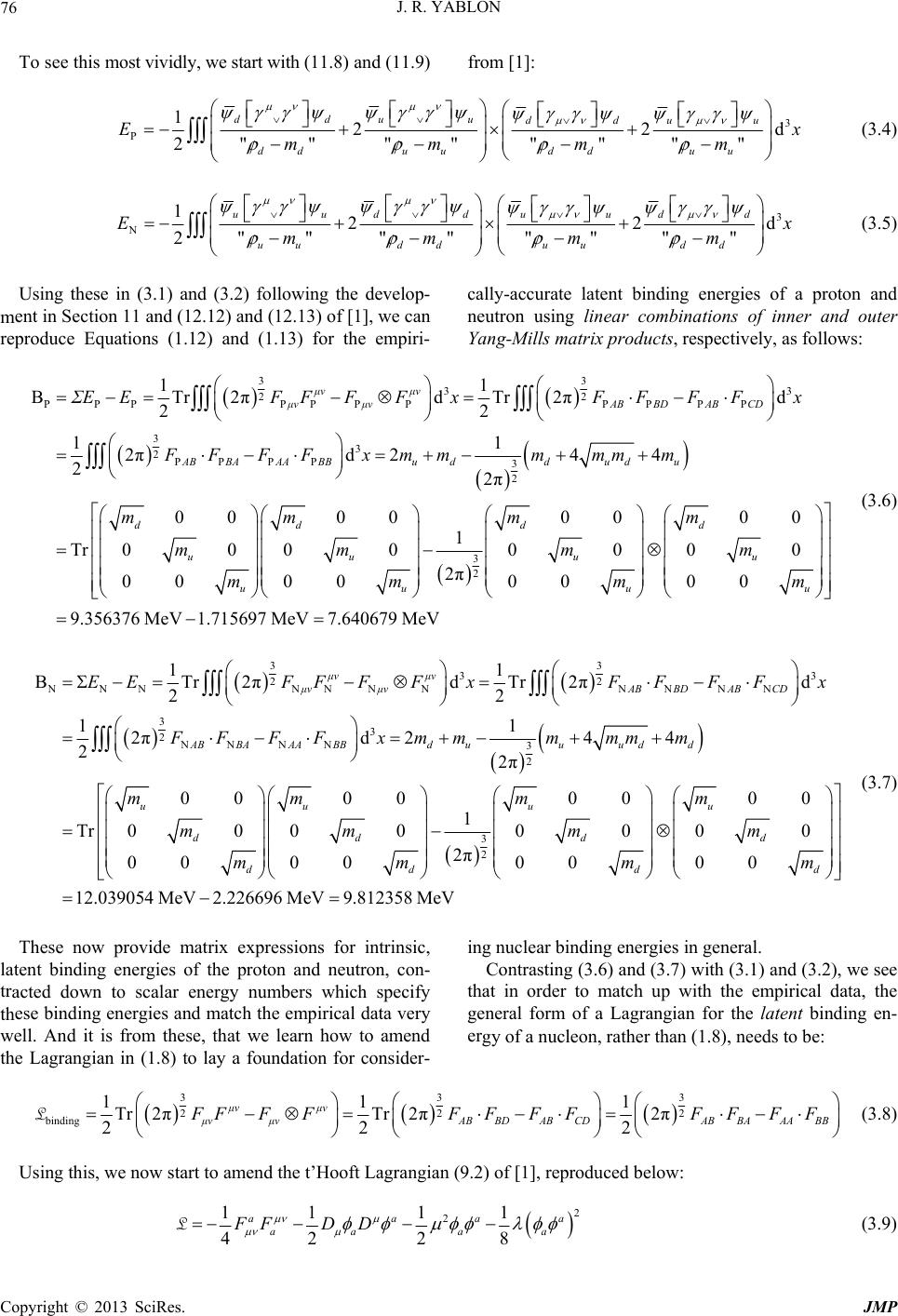 J. R. YABLON 76 To see this most vividly, we start with (11.8) and (11.9) from [1]: 3 " u dduu P 12 2" "" ddu Emm 2 d """" dduudd uu x mm (3.4) 3 122d " uudd uudd dd E x m (3.5) ment in Section 11 and (12.12) and (12.13) of [1], we can produce Equations (1.12) and (1.13) for the empiri- cally-accurate latent binding energies of neutron using linear combinations of inner and outer Yang-Mills matrix products, respectively, as follows: N2" """" "" uu dd uu mm m Using these in (3.1) and (3.2) following the develop- re a proton and 33 22 PPP PPPPPPPP 11 BTr2πdTr2πd 22 μν μν μν μνAB BDAB CD ΣEEFFFFF FFFx 33 33 2PP PP 3 2 11 2πd2 4 4 22π 00 00 Tr0000 0000 AB BAAABBuddu du dd uu uu x FFFFxmmmmmm mm mm mm 3 2 00 00 10000 2π00 00 9.356376 MeV1.715697 MeV7.640679 MeV dd uu uu mm mm mm (3.6) 33 33 22 NNNNNNNNN NN 33 2NN NN3 2 11 BTr2πdTr2πd 22 11 2πd24 4 22π 00 00 μν μν μν μνABBDAB CD ABBAAABBduuu dd EEFFFFxFFFFx FF FFxmmmmmm mm T r0000 0000 uu dd dd mm mm 3 2 100 2π00 12.039054 MeV2.226696 MeV9.812358 MeV uu These now provide matrix expressions for intrinsic, latent binding energies of the proton and neutron, con- 00 00 00 00 dd dd mm mm mm (3.7) acted down to scalar energy numbers which specify th ing nuclear binding energies in general. Contrasting (3.6) and (3.7) with (3.1) and (3.2), we see that in order to match up with the empirical data, the tent binding en- er tr ese binding energies and match the empirical data very well. And it is from these, that we learn how to amend the Lagrangian in (1.8) to lay a foundation for consider- general form of a Lagrangian for the la gy of a nucleon, rather than (1.8), needs to be: 33 22 binding 11 Tr 2πTr 2π 22 μν μν μν μν FF FF L 3 2 1 2π BDABCDABBAAA BB FFFFF FF 2 AB F (3.8) Using this, we now start to amend the t’Hooft Lagrangian (9.2) of [1], reproduced below: 2 2 11 11 aaaa FFD D L (3.9) 42 28 aa a a Copyright © 2013 SciRes. JMP 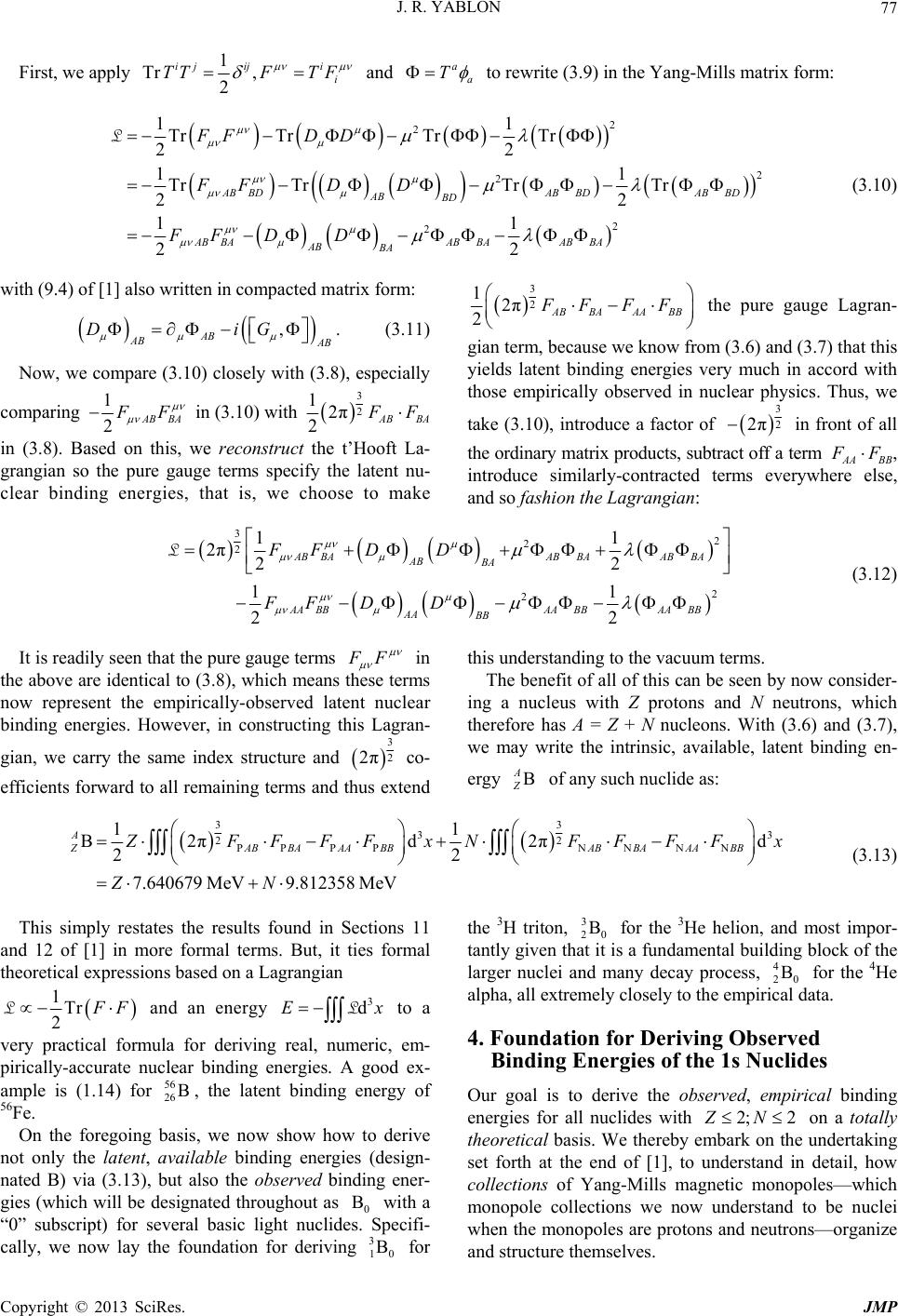 J. R. YABLON 77 First, we apply 1 Tr , 2 ij iji i TFTT F and a a T to rewrite (3.9) in the Yang-Mills matrix form: 2 2 2 2 2 11 Tr TrTr 22 11 Tr TrTrTr 22 11 22 ABBDAB BDAB BD AB BD AB BAABBAABBA AB BA FFD D FFD D FF DD (3.10) with (9.4) of [1] also written in compacted matrix form: ,G . (3.11) Now, we compare (3.10) closely with (3.8), especially 2 Tr L 3 2 12π 2AB BAAA BB FF FF the pure gauge Lagran- gian term, because we know from (3.6) and (3.7) that this yields latent binding energies those empirically observed in nuclear physics. Thus, we AB Di AB AB comparing 1 AB BA 2 F F in (3.10) with 3 2 12πAB B 2 F F A in the pure gay the latent nu ng energies, that ake (3.8). Based on this, we reconstruct the t’Hooft La- grangian souge terms specif- clear bindiis, we choose to m very much in accord with take (3.10), introduce a factor of 3 2 2π in front of all the ordinary matrix products, subtract off a term AABB F F , introduce similarly-contracted teywhere else, and so fashion the Lagrangian: rms ever 2 2 11 22 AA BBAA BBAA BB AA BB FF D D (3.12) It is readily seenure gauge terms 3 21 2π 2 AB BAAB FF DD L2 21 2 AB BAABBA BA F F that the p in the above are identical to (3.8), which means these terms ow represent the empiricallytent nuclear biis Lag this understanding to the vacuum terms. The benefit of all of this can be seen by now consider- ing a nucleus with Z protons and N neutrons, which (3.6) and (3.7), w n-observed la nding energies. However, in constructing thran- gian, we carry the same index structure and 3 2 2π co- efficients forward to all remaining terms and thus extend therefore has A = Z + N nucleons. With e may write the intrinsic, available, latent binding en- ergy B A Z of any such nuclide as: 33 33 2d 2 7.640679 MeV9.812358 MeV BB 2 PP PP B2πd 2 ZA BBAAABB 2 NN NN πABBAAA 11 A Z FF FFx NF FFF x ZN (3.13) This simply restates th in Sections 11 and 12 of [1] in more formt ties formal eoretical expressions based on a Lagrangian e results found al terms. But, i th 1Tr 2 F F L and an energy 3 dEx L to a very practical formula for deriving real, numeric, em- pirically-accurate ergies. A goo ample is (1.14) for B, the latent binding energy of B) via (3.13), but also the observed binding ener- gi the 3H triton, 3 20 B for the 3He helion, an tantly given that it is a fundamental building block of the larger nuclei and many decay process, 4B for the 4He ta. rtaking tail, how which monopnuclei nuclear binding end ex- 56 26 56Fe. On the foregoing basis, we now show how to derive not only the latent, available binding energies (design- nated es (which will be designated throughout as 0 B with a “0” subscript) for several basic light nuclides. Specifi- cally, we now lay the foundation for deriving 3 10 B for 20 alpha, all extremely closely to the empirical da 4. Foundation for Deriving Observed Binding Energies of the 1s Nuclides Our goal is to derive the observed, empirical binding energies for all nuclides with 2; 2ZN on a totally theoretical basis. We thereby embark on the unde d most impor- set forth at the end of [1], to understand in de collections of Yang-Mills magnetic monopoles— ole collections we now understand to be when the monopoles are protons and neutrons—organize and structure themselves. Copyright © 2013 SciRes. JMP 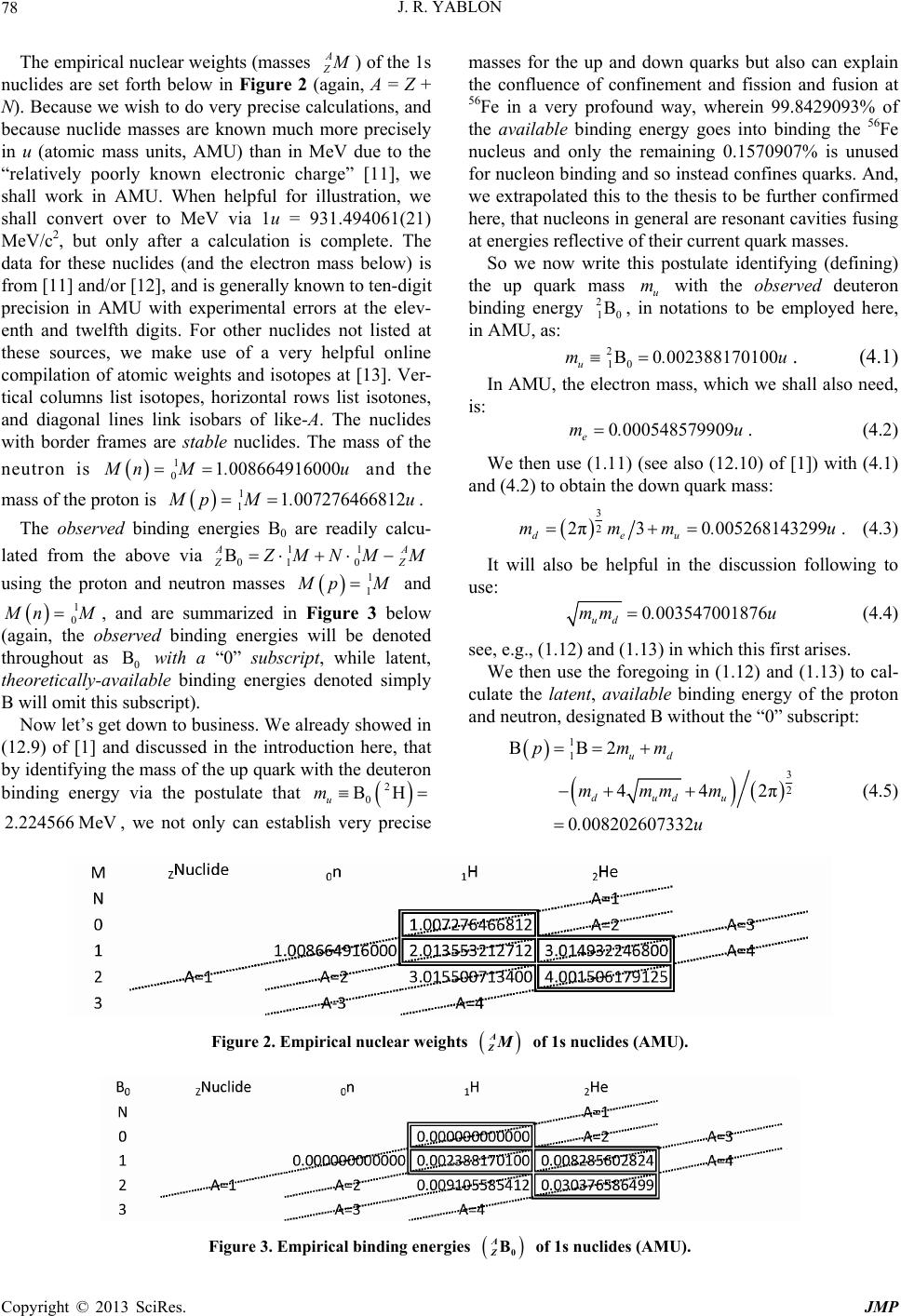 J. R. YABLON 78 The empirical nuclear weights (masses A Z M ) of the 1s nuclides are set forth below in Figure 2 (again, A = Z + N). Because we wish to do very precise calculations, and because nuclide masses are known much more precisely in u (atomic mass units, AMU) than in MeV due to the “relatively poorly known electronic charge” [11], we shall work in AMU. When helpful for illustration, we shall convert over to MeV via 1u = 931.494061(21) MeV/c2, but only after a calculation is complete. The data for these nuclides (and the electron mass below) is from [11] and/or [12], and is generally known to ten-digit precision in AMU with experimental errors at the elev- enth and twelfth digits. For other nuclides not listed at these sources, we make use of a very helpful online compilation of atomic weights and isotopes at [13]. Ver- tical columns list isotopes, horizontal rows list isotones, and diagonal lines link isobars of like-A. The nuclides with border frames are stable nuclides. The mass of the neutron is 1 01 008664916000 M nM. u and the mass of the proton is 1 11007276466812 M pM. u . The observed binding energies B0 are readily calcu- lated from the above via 11 01 0 B AA ZZ Z MNM M using the proton and neutron masses 1 1 M pM and 1 0 M nM, ae 3 below nd are summarized in Figur nding energies will be denoted energies denoted simply already show (12.9) of [1] (again, the observed bi throughout as 0 B with a “0” subscript, while latent, theoretically-available binding B will omit this subscript). Now let’s get down to business. We ed in and discussed in the introduction here, that by identifying the mass of the up quark with the deuteron binding energy via the postulate that 2 0 BH u m 2.224566 MeV , we not only can establish very precise masses for the up and down quarks but also can explain the confluence of confinement and fission and fusion at 56Fe in a very profound way, wherein 99.8429093% of the available binding energy goes into binding the 56Fe nucleus and only the remaining 0.1570907% is unused for nucleon binding and so instead confines quarks. And, we extrapolated this to the thesis to be further confirmed here, that nucleons in general are resonant cavities fusing at energies reflective of their current quark masses. So we now write this postulate identifying (defining) the up quark mass u with the observed deuteron binding energy , in notations to be employed here, in AMU, as: m 2 10 B 2 10 B0 002388170100 u m. u 0 000548579909 e m. u . (4.1) In AMU, the electron mass, which we shall also need, is: . (4.2) We then use (1.11) (see also (12.10) of [1]) with (4.1) and (4.2) to obtain the down quark mass: 3 2 2π30 005268143299 deu mmm.u . (4.3) It will also be helpful in the discussion following to use: 0 003547001876 ud mm .u (4.4) see, e.g., (1.12) and (1.13) in which this first arises. We then use the foregoing in (1.12) and (1.13) to cal- culate the latent, available binding energy of the proton and neutron, designated B without the “0” subscript: 1 1 3 2 BB2 442π 0 008202607332 ud dudu pmm mmmm .u (4.5) Figure 2. Empirical nuclear weights A ZM of 1s nuclides (AMU). Figure 3. Empirical binding energies A Z0 B of 1s nuclides (AMU). Copyright © 2013 SciRes. JMP 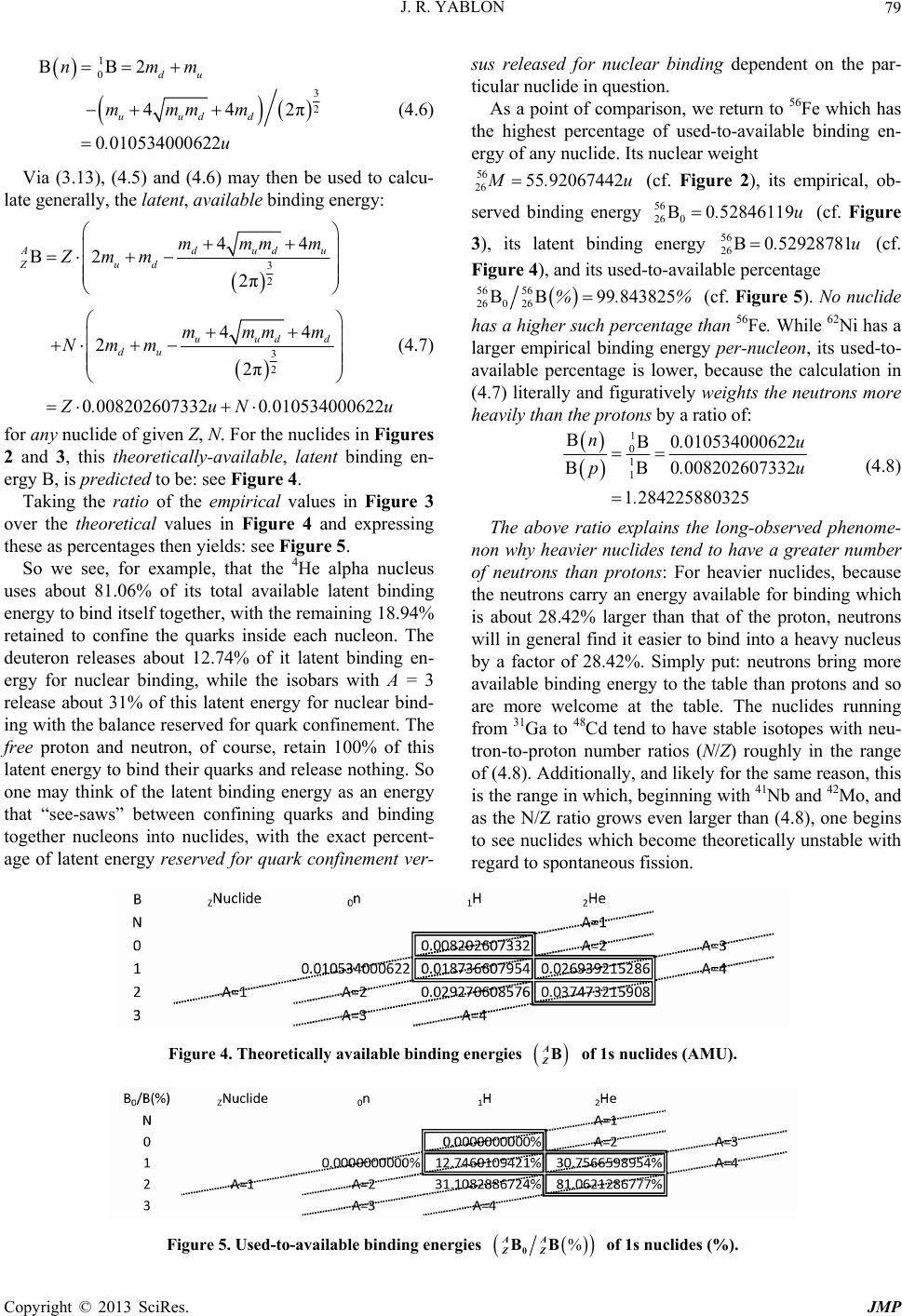 J. R. YABLON 79 1 0 BB2 44 0 010534000622 du uu nm mmm .u 3 2 2π dd m m (4.6) Via (3.13), (4.5) and (4.6) may then be used to calcu- late generally, the latent, available binding energy: 3 2 44 B2 2π 44 2 0 0082026073320010534000622 dudu A Zud uudd mmmm Zmm mmmm Nmm 3 2 2π du Z .uN.u (4.7) for any nuclide of given Z, N. For the nuclides in Figures 2 and 3, this theoretically-available, latent binding en- ergy B, is predicted to be: see Figure 4. Taking the ratio of the empirica l values in Figure 3 over the theoretical values in Figure 4 and expre these as percentages then yields: see Figure 5. So we see, for example, that the 4He alpha nucleus uses about 81.06% of its total available latent binding sus released for nuclear binding dependent on the par- ticular nuclide in question. As a point of comparison, we return to 56Fe which has the highest percentage of used-to-available binding en- ergy of any nuclide. Its nuclear weight 56 26 55 92067442 M .u (cf. Figure 2), its empirical, ob- rved 0 52846119.u (cf. Figure ailable percentage ssing energy to bind itself together, with the remaining 18.94% retained to confine the quarks inside each nucleon. The deuteron releases about 12.74% of it latent binding en- ergy for nuclear binding, while the isobars with A = 3 release about 31% of this latent energy for nuclear bind- ing with the balance reserved for quark confinement. The free proton and neutron, of course, retain 100% of this latent energy to bind their quarks and release nothing. So one may think of the latent binding energy as an energy that “see-saws” between confining quarks and binding together nucleons into nuclides, with the exact percent- age of latent energy reserved for quark confinement ver- se binding energy 56 26 0 B 3), its latent binding energy 56 26 B0 52928781.u (cf. Figure 4), and its used-to-av 56 eon, its used-to- available percentage tively weights the n 56 26026 BB99843825%. % (cf. Figure 5). No nuclide has a higher such percentage than 56Fe. While 62Ni has a larger empirical binding energy per-nucl is lower, because the calculation in (4.7) literally and figuraeutrons more heavily than the protons by a ratio of: 1 0 1 BB0 010534000622 B0 008202607332B n.u p. u 1 2% lare proton, neutrons will in general find it easier to bind into a he by a factor of 28.42%. Simply put: neutrons available binding energy to the table than protons and so ar 1284225880325. The above ratio explains the long-observed phenome- non why heavier nuclides tend to have a greater number of neutrons than protons: For heavier nuclides, because the neutrons carry an energy available for binding which is about 28.4ger than that of th (4.8) avy nucleus bring more e more welcome at the table. The nuclides running from 31Ga to 48Cd tend to have stable isotopes with neu- tron-to-proton number ratios (N/Z) roughly in the range of (4.8). Additionally, and likely for the same reason, this is the range in which, beginning with 41Nb and 42Mo, and as the N/Z ratio grows even larger than (4.8), one begins to see nuclides which become theoretically unstable with regard to spontaneous fission. nergies Figure 4. Theoretically available binding A ZB of 1s nuclides (AM eU). % AA ZZ0 BB of 1s nuclides (%). Figure 5. Used-to-available binding energies Copyright © 2013 SciRes. JMP  J. R. YABLON 80 Next, we subtract Figure 3 from Figure 4, to obtain the unused (U) b0 AAA ZZZ UBB for each nuclide. Thesnergies represent the amount of the latent binding energies reserved for and channeled into intra-nucleon quark confinement, rather than released and used for inter-nucleon binding. Of course, for the proton and neutron, all of this energy is unused; it is fully re e quarks. These unu gi inding energy e unused binding e served and channeled into confining sed, reserved-for-confinement ener- th es are: see Figure 6. Finally, to lay the groundwork for predicting the observed binding energies B0 in Figure 3, let us refer to (3.6) and (3.7), remove the trace, and specify two (3 × 3) × (3 × 3) outer product matrices, one for the proton, PABCD E, and one for the neutron, NABCD E, according to: 33 3 22 PPP 1 2π2πd 2 00 ABCDAB CD EFFx m 00 0000 0000 dd uu uu m mm mm (4.9) 33 22 NN 3 N 2π2πd 2 00 00 0000 00 00 ABCDABCD uu dd dd EFFx mm mm mm (4.10) From the above, one can readily obtain the eighteen non-zero diagonal outer product components (nine for the proton and nine for thPNABCDABCD EE 1 e neutron), with 0 otherwise: N1111P2222 P P3322 P1111 N2222N 3333 P2233 3 2 N1122 N1133 N2211 3 2 N3311 2π 2π u ud EEEE Em EEE E EEE Emm This is why (4.1), (4.3) and (4.4) will be of interest in the development following. With the “toolkit” (4.9) to (4.11) we now have all ingredients needed to closely deduce the empirical binding energies in Figure 3 on totally theoretical grounds. We start with the alpha, 4He. 5. Prediction of the Alpha Nuclide Binding Energy to 3 Parts in One Million, and ia d- ing a is 4 2Uing over the toolkit (4.11), 3333 N2233 3 2 N3322 P1122P1133 P2211 P3311 2π d Em EEEE (4.11) How Binding Energies Are Yang-Mills Tensor Components The alpha particle is the 4He nucleus. It is highly stable, with fully saturated 1s shells for protons and neutrons, and is central to many aspects of nuclear physics includ- ing the decay of nuclides into more stable states v so-called alpha decay. In this way, it is a bedrock buil block of nuclear physics. The unused binding energy in Figure 6 for the alph 0 007096629409.u. Look we see 20 007094003752 ud mm .u, so 4 2U is very close to being twice the value of ud mm in (4.4). In fact, these energies are equal to about 2.26 parts per mil- lion! Might this be an indication that the alpha uses all its latent binding energy less 2ud mm for nuclear binding, wi th the 2ud mm balance reserved on the other side of e quarks within each of its four the “see saw” to confin First, let’s look at the numben ke sense less nucleons? ers, th examine theoretical reasons why this may ma. If in fact this numerical coincidence is not just a coin- cidence but has real physical meaning, this would mean the empirical binding energy 4 20 B of the alpha is pre- dicted to be (4.7) for 4 2B, 2m ud m, that is: 4 2 0Predicted3 2 44 B22 2π dudu ud mmmm mm 3 2 44 22 2π uu dd du mm mm mm (5.1) 20.030379212155 ud mm u where we calculate using, ud mmfrom (4.1), (4.3), and Figure 6. Unused latent binding energies A ZU of 1s nuclides (AMU). Copyright © 2013 SciRes. JMP 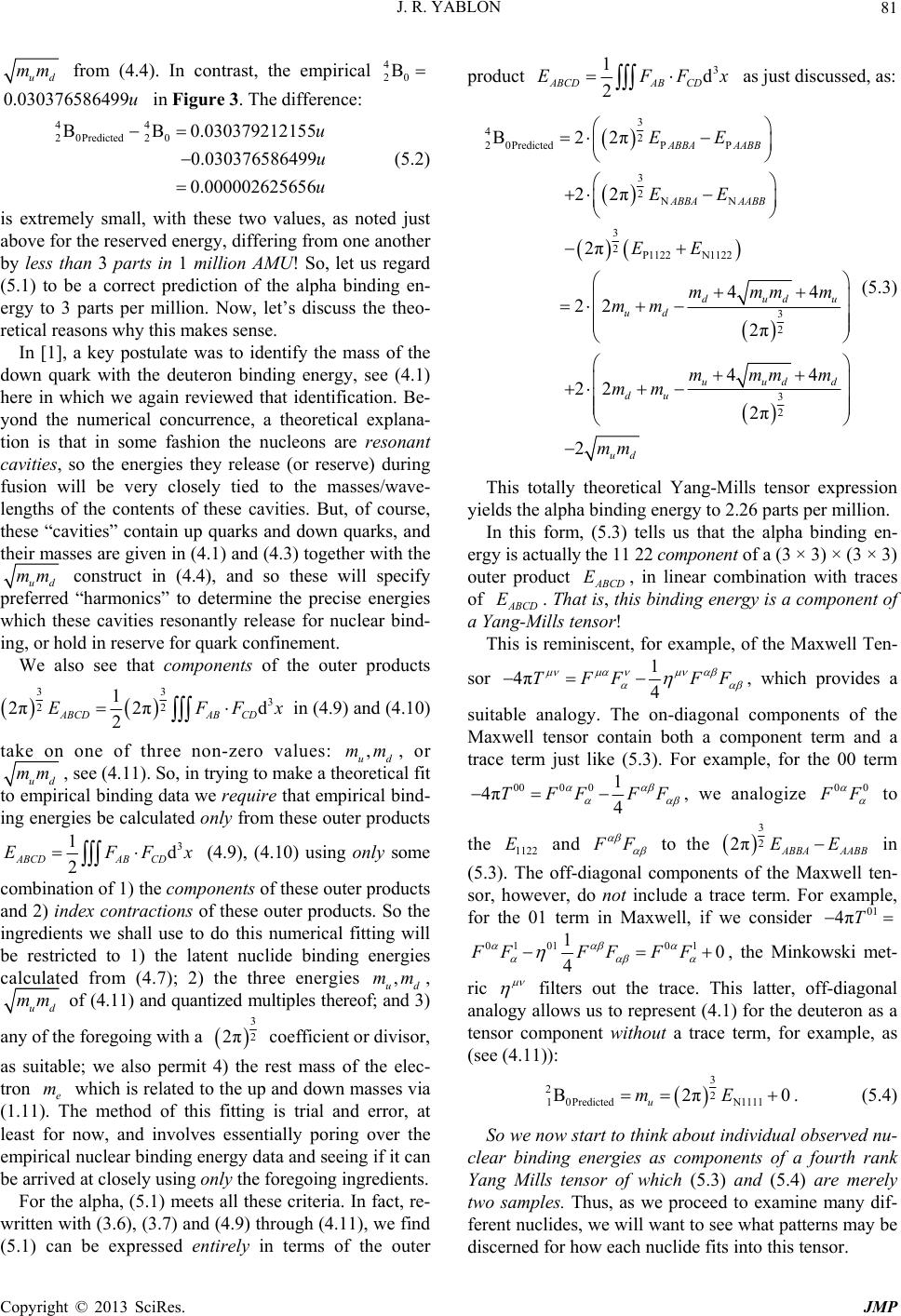 J. R. YABLON 81 ud mm from (4.4). In contrast,irical 4 20 B the emp 0.030376586499u in Figure 3. The difference: 0379212155 0376586499 0002625656 u u u (5.2) is extremely small, with these two values, as noted just above for the reserved energy, differing from one another less than 3 parts in 1 .1) to ng en- ergy to theo retical reasons why In [1], a key postulate was to identify the mass of the down quark with the deuteron binding ener here in which we again reviewed that iden yond the numerical concurrence, a theoretical explana- 44 2 0Predicted2 0 BB 0.03 0.03 0.00 by million AMU! So, let us regard (5be a correct prediction of the alpha bindi 3 parts per million. Now, let’s discuss the- this makes sense. gy, see (4.1) tification. Be- tion is that in some fashion the nucleons are resonant cavities, so the energies they release (or reserve) during fusion will be very closely tied to the masses/wave- lengths of the contents of these cavities. But, of course, these “cavities” contain up quarks and down quarks, and their masses are given in (4.1) and (4.3) together with the ud mm construct in (4.4), and so these will specify preferred “harmonics” to determine the precise energies which these cavities resonantly release for nuclear bind- ing, or hold in reserve for quark confinement. We also see that components of the outer products 33 3 22 1 2π2πd 2 ABCDAB CD EFFx in (4.9) and (4.10) take on one of three non-zero values: , ud mm, or ud mm , see (4.11). So, in trying to make a theoretical fit to empirical binding data we require that empirical bind- ing energies be calculated only from these outer products 3 1d 2 ABCDABCD EFFx (4.9), (4.10) using only some combination of 1) the components of these outer products d 2) index contractions of these outer products. So the an ingredients we shall use to do this nu be restricted to 1) the latent nuclide binding energies s u m merical fitting will calculated from (4.7); 2) the three energie,d m, ud mm of (4.11) and quantized multiples thereof; and 3) any of the foregoing with a 3 2 2π coefficient or divisor, as suitable; we also permit 4) the rest mass of the elec- to the up and down masses via tron e m which is related act, re itten (5.1) ca product 3 1d 2 ABCDABCD EFFx as just discussed, as: (1.11). The method of this fitting is trial and error, at least for now, and involves essentially poring over the empirical nuclear binding energy data and seeing if it can be arrived at closely using only the foregoing ingredients. For the alpha, (5.1) meets all these criteria. In f- wr with (3.6), (3.7) and (4.9) through (4.11), we find n be expressed entirely in terms of the outer 3 42 2 0PredictedPP 3 2NN 3 21122 B22π 22π 2π 44 ABBA AABB ABBA AABB d EE EE EE mmmm (5.3) . tually the 11 22 componen outer product ABCD E, in linear combination with traces of ABCD E. That is, this binding energy is a component of a Yang-Mills tensor! This is reminiscent, for example, of the Maxwell Ten- sor P1122 N 3 22 u du ud mm 2 3 2 2π 44 22 2π 2 uu dd du ud mm mm mm mm This totally theoretical Yang-Mills tensor expression yields the alpha binding energy to 2.26 parts per million. In this form, (53) tells us that the alpha binding en- ergy is act of a (3 × 3) × (3 × 3) 1 4π 4 TFF FF , which provides a suitable analogy. The on-diagonal components of the Maxwell tensor contain both a component term and a trace term just like (5.3). For example, for the 00 term 00001 4π 4 TFF FF , we analogize 00 F F to the 1122 E and F F to the 3 2 2πABBA AABB EE in (5.3). The off-diagonal components of the Maxwell ten- sor, however, do not include a trace term. For example, for the 01 term in Maxwell, if we consider 01 4πT 01 0101 1 FF 0 4FF FF , the Minkowski met- ric filters out the trace. This latter, off-diagonal an alogy allows us to represent (4.1) for the deuteron as a tensor component without a trace term, for example, as (see (4.11)): 3 2 1 0Predicted B2N1111 2π0 u mE . (5.4) r binding energies as compone So we now start to think about individual observed nu- clea nts of a fourth rank Yang Mills tensor of which (5.3) and (5.4) are merely two samples. Thus, as we proceed to examine many dif- ferent nuclides, we will want to see what patterns may be discerned for how each nuclide fits into this tensor. Copyright © 2013 SciRes. JMP 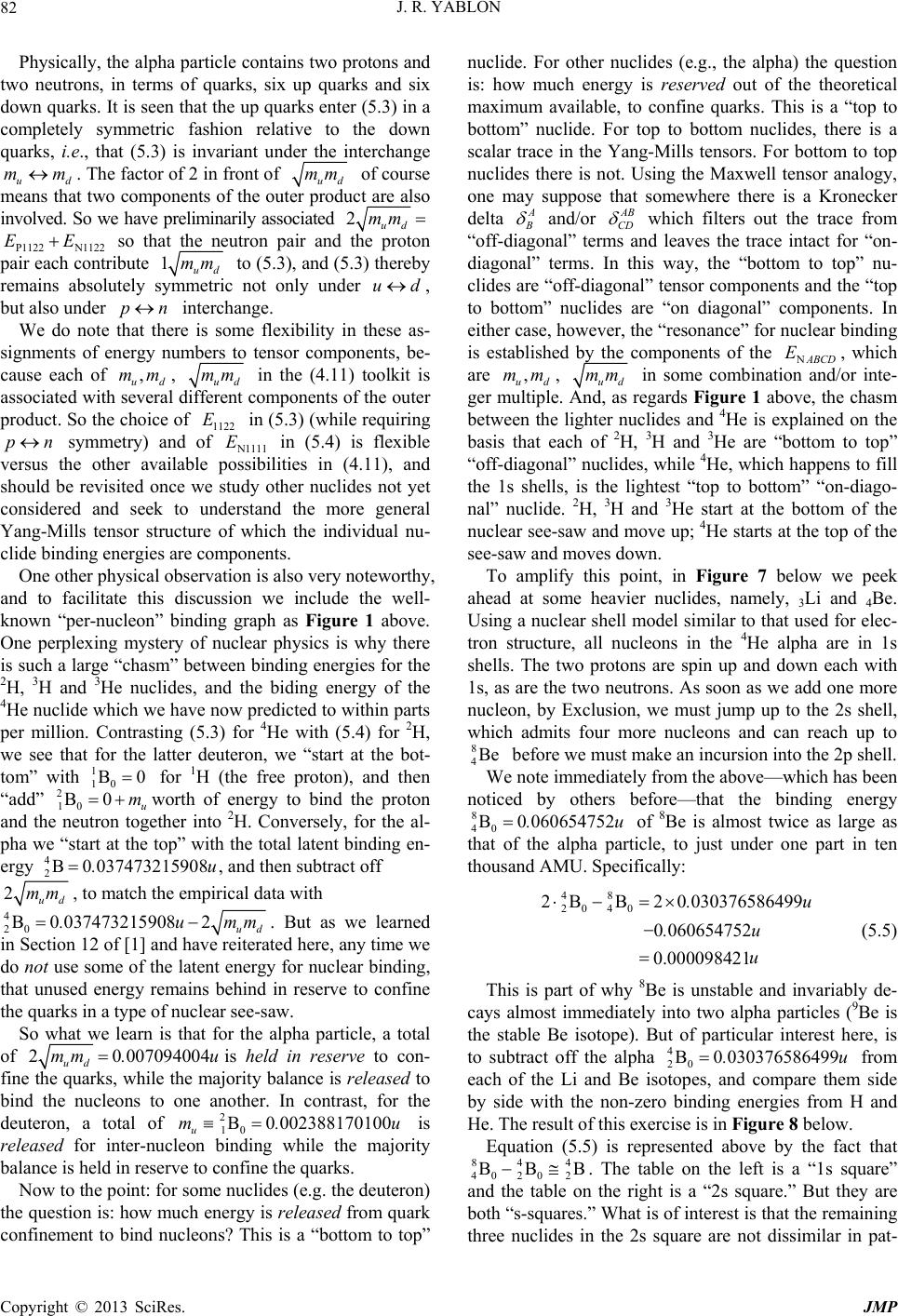 J. R. YABLON 82 Physically, the alpha partiotons two neutrons, in terms of qnd quarks enter (5.3) in letemetric relative to the do cle contains two prand uarks, six up quarks a six down quarks. It is seen that the upa comply symfashion wn quarks, i.e., that (5.3) is invariant under the interchange ud mm. The factor of 2 in front of ud mm of course means that two components of the outer produc t are also involved. So we have preliminarily associated 2ud mm n pair and the proton P1122 EE so that t ea N1122 ch c he neutro pairontribute 1ud mm to (5.3), and (5.3) thereby remains absolutely symmetric not only under ud , but also under pn interchange. We do note that there is some flexibility in these as- signments of energy numbers to tensor components, be- ud , cause each of ,mm ud mm in the (4 ral different components of the outer l nu- cl is such a ng energ per million. C atter deu d the mwoto bind the proton 473215908 , an .11) toolkit is associated pr with seve oduct. So the choice of 1122 E in (5.3) (while requiring pn symmetry) and of N111 1 E in (5.4) is flexible versus the other available possibilities in (4.11), and should be revisited once we study other nuclides not yet considered and seek to understand the more general Yang-Mills tensor structure of which the individua ide binding energies are components. One other physical observation is also very noteworthy, and to facilitate this discussion we include the well- known “per-nucleon” binding graph as Figure 1 above. One perplexing mystery of nuclear physics is why there large “chasm” between bindiies for the 2H, 3H and 3He nuclides, and the biding energy of the 4He nuclide which we have now predicted to within parts ontrasting (5.3) for 4He with (5.4) for 2H, we see that for the lteron, we “start at the bot- tom” with 1 10 B0 for 1H (the free proton), ann “add” 2B0rth of energy 10 u d the neutron together into 2H. Conversely, for the al- pha we “start at the top” with the total latent binding en- ergy 4 2B0 037.ud then subtract off an 2ud mm , to match the empirical data with 4037473215908 2.um. But as we learned in Section 12 of [1] and have reiterated here, any time we do not use some of the latent energy for nuclear binding, that unused energy remains behind in reserve to confine the quarks in a type of nuclear see-saw. So what we learn is that for the alpha particle, a total of 20 B 0ud m 20 007094004 ud mm .uis held in reserve to con- fine the quarks, while the majority balance is released to bind the nucleons to one another. In contrast, for the deuteron, a total of 2 10 B0 002388170100 u m. u is released for inter-nucleon binding while the majority balance is held in reserve to confine the quarks. Now to the point: for some nuclides (e.g. the deuteron) the question is: how much energy is released from quark confinement to bind nucleons? This is a “bottom to top” nuclide. For uclides (e.g., the alpha) the question is: howgy is reserved out of the theoretical maximum available, to confine quarks. This is a “top to bottom” nuclide. For top to bottom nuclides, there is a scalarls tensors. For bottom to other n much ener trace in the Yang-Mil top nuclides or analogy, one may suppose that somewhere there is not. Using the Maxwell tens there is a Kronecker delta A B and/or AB CD which filters out the trace from “off-diagonal” terms and leaves the trace intact for “on- diagonal” terms. In this way, the “bottom to top” nu- clides are “off-diagonal” tensor components and the “top to bottom” nuclides are “on diagonal” components. In either case, however, the “resonance” for nuclear binding is established by the components of the NABCD E, which are , ud mm, ud mm in some combination and/or inte- ger multiple. And, as regards Figure 1 above, the chasm between the lighter nuclides and 4He is explained on the basis that each of 2H, 3H and 3He are “bottom to top” “o 4 ff-diagonal” nuclides, while He, which happens to fill the 1s shells, is the lightest “top to bottom” “on-diago- nal” nuclide. 2H, 3H and 3He start at the bottom of the nuclear see-saw and move up; 4He starts at the top of the see-saw and moves down. To amplify this point, in Figure 7 below we peek ahead at some heavier nuclides, namely, 3Li and 4Be. Using a nuclear shell model similar to that used for elec- tron structure, all nucleons in the 4He alpha are in 1s shells. The two protons are spin up and down each with 1s, as ar the two netrons. As soon as we add one more nucleon, by Exclusion, we must jump up to the 2s shell, which admits four more nucleons and can reach up to 8 4Be before we must make an incursion into the 2p shell. We note immediately from the above—which has been noticed by others before—that the binding energy 8 40 B0 060654752.u of 8Be is almost twice as large as that of the alpha particle, to just under one part in ten thousand AMU. Specifically: 48 20 40 2BB20 030376586499 0 060654752 0.000098421 .u .u u (5.5) This is part of why 8Be is unstable and invariably de- cays almost immediately into two alpha particles (9Be is the stable Be isotope). But e u of particular interest here, is to thre subtract off the alpha 4 20 B0 030376586499.u from each of the Li and Be isotopes, and compare them side by side with the non-zero binding energies from H and He. The result of this exercise is in Figure 8 below. Equation (5.5) is represented above by the fact that 84 4 40 202 BB B. The table on the left is a “1s square” and the table on the right is a “2s square.” But they are both “s-squares.” What is of interest is that the remaining e nuclides in the 2s square are not dissimilar in pat- Copyright © 2013 SciRes. JMP 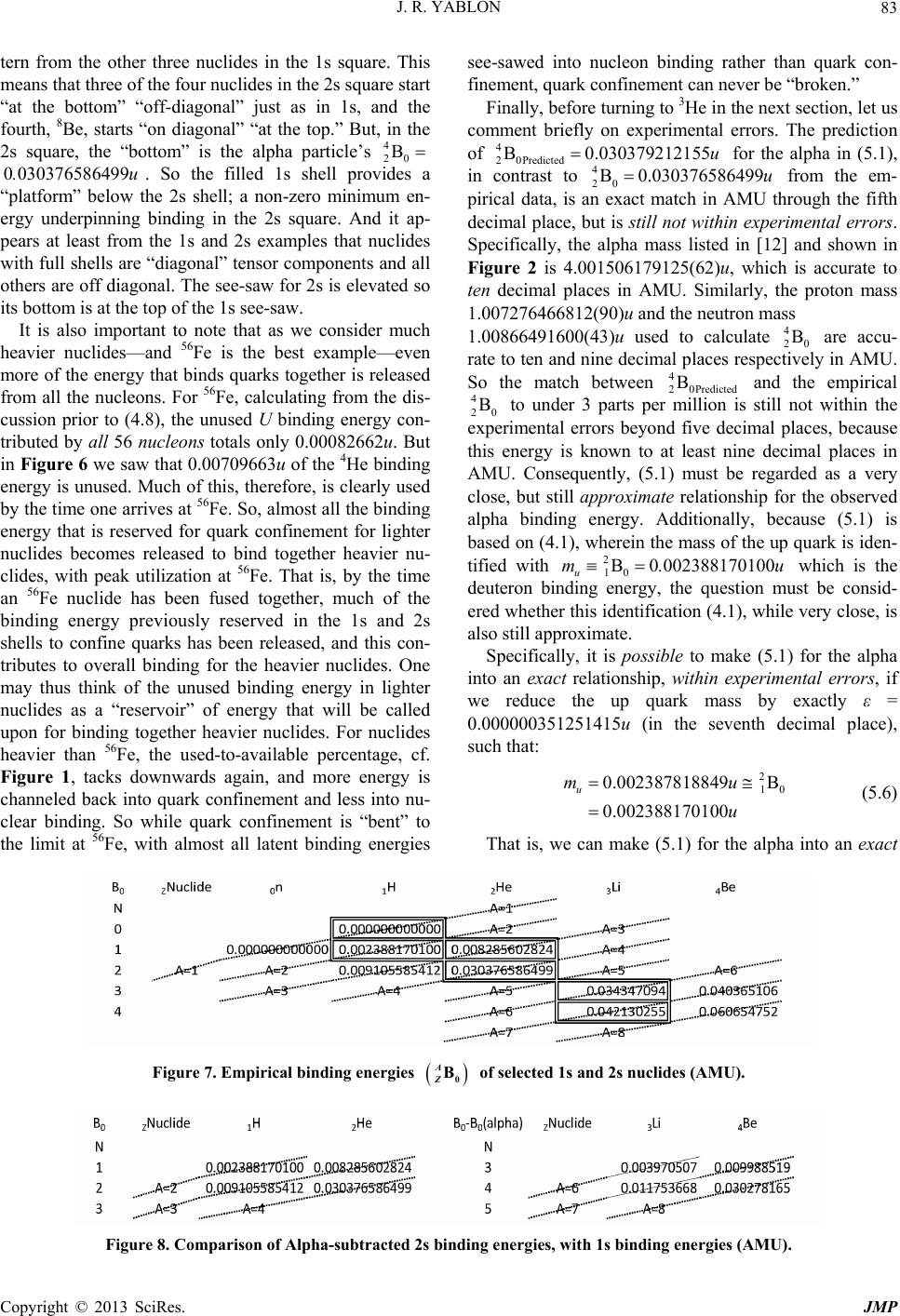 J. R. YABLON ight ©s. JMP 83 te “at the bottom” “of e alpharticle’s 4 20 B rn from the other three nuclides in the 1s square. This means that three of the four nuclides in the 2s square start f-diagonal” just as in 1s, and the fourth, 8Be, starts “on diagonal” “at the top.” But, in the 2s square, the “bottom” is th pa 0376586499.u. So the filled 1s shell provides a ” below the 2s shell; a non-zeminimum en- nderpinning binding in the 2e. least from the 1s and 2s e nuclides of 4 20Predicted B 0.030379212155u for the alpha in (5.1), in contrast to 4 20 B 0.030376586499u from the em- pirical data, is an exact match in AMU through the fifth decimal place, but is still not within experimental errors. Specifically, the alpha mass listed in [12] and shown in Figure 2 is 4.001506179125(62)u, which is accurate to ten decimal places in AMU. Similarly, the proton mass 1.00727646681 2(90)u and the neutron mass 1.00866491600 (43)u used to calculate 4 20 B are accu- rate to ten and nine decimal places respectively in AMU. So the match between 4 2 0Predicted B and the empirical 4 20 B to under 3 parts per million is still not within the experimental errors beyond five decimal places, because this energy is known to at least nine decimal places in AMU. Consequently, (5.1) must be regarded as a very close, but still approximate relationship for the observed alpha binding energy. Additionally, because (5.1) is based on (4.1), wherein the mass of the up quark is iden- tified with 2 10 B0 002388170100 u m. u which is the deuteron binding energy, the question must be consid- ered whether this identification (4.1), while very close, is also still approximate. Specifically, it is possible to make (5.1) for the alpha into an exact relationship, within experimental errors, if we reduce the up quark mass by exactly ε = 0.00000035125 1415u (in the seventh decimal place), such that: 2 10 0.002387818849 B 0.0023881701 00 u mu u (5.6) That is, we can make (5.1) for the alpha into an exact 0 03 “platform ergy u pears at wi tribute ro s squar xamples that And it ap- th full shells are “diagonal” tensor components and all others are off diagonal. The see-saw for 2s is elevated so its bottom is at the top of the 1s see-saw. It is also important to note that as we consider much heavier nuclides—and 56Fe is the best example—even more of the energy that binds quarks together is released from all the nucleons. For 56Fe, calculating from the dis- cussion prior to (4.8), the unused U binding energy con- d by all 56 nucleons totals only 0.00082662u. But in Figure 6 we saw that 0.00709663u of the 4He binding energy is unused. Much of this, therefore, is clearly used by the time one arrives at 56Fe. So, almost all the binding energy that is reserved for quark confinement for lighter nuclides becomes released to bind together heavier nu- clides, with peak utilization at 56Fe. That is, by the time an 56Fe nuclide has been fused together, much of the binding energy previously reserved in the 1s and 2s shells to confine quarks has been released, and this con- tributes to overall binding for the heavier nuclides. One may thus think of the unused binding energy in lighter nuclides as a “reservoir” of energy that will be called upon for binding together heavier nuclides. For nuclides heavier than 56Fe, the used-to-available percentage, cf. Figure 1, tacks downwards again, and more energy is channeled back into quark confinement and less into nu- clear binding. So while quark confinement is “bent” to the limit at 56Fe, with almost all latent binding energies see-sawed into nucleon binding rather than quark con- finement, quark confinement can never be “broken.” Finally, before turning to 3He in the next section, let us comment briefly on experimental errors. The prediction Figure 7. Empirical binding energies 0 B of selected 1s and 2s nuclides (AMU). A Z inding energies, with 1s binding energies (AMU). Figure 8. Comparison of Alpha-subtracted 2s b Copyr 2013 SciRe 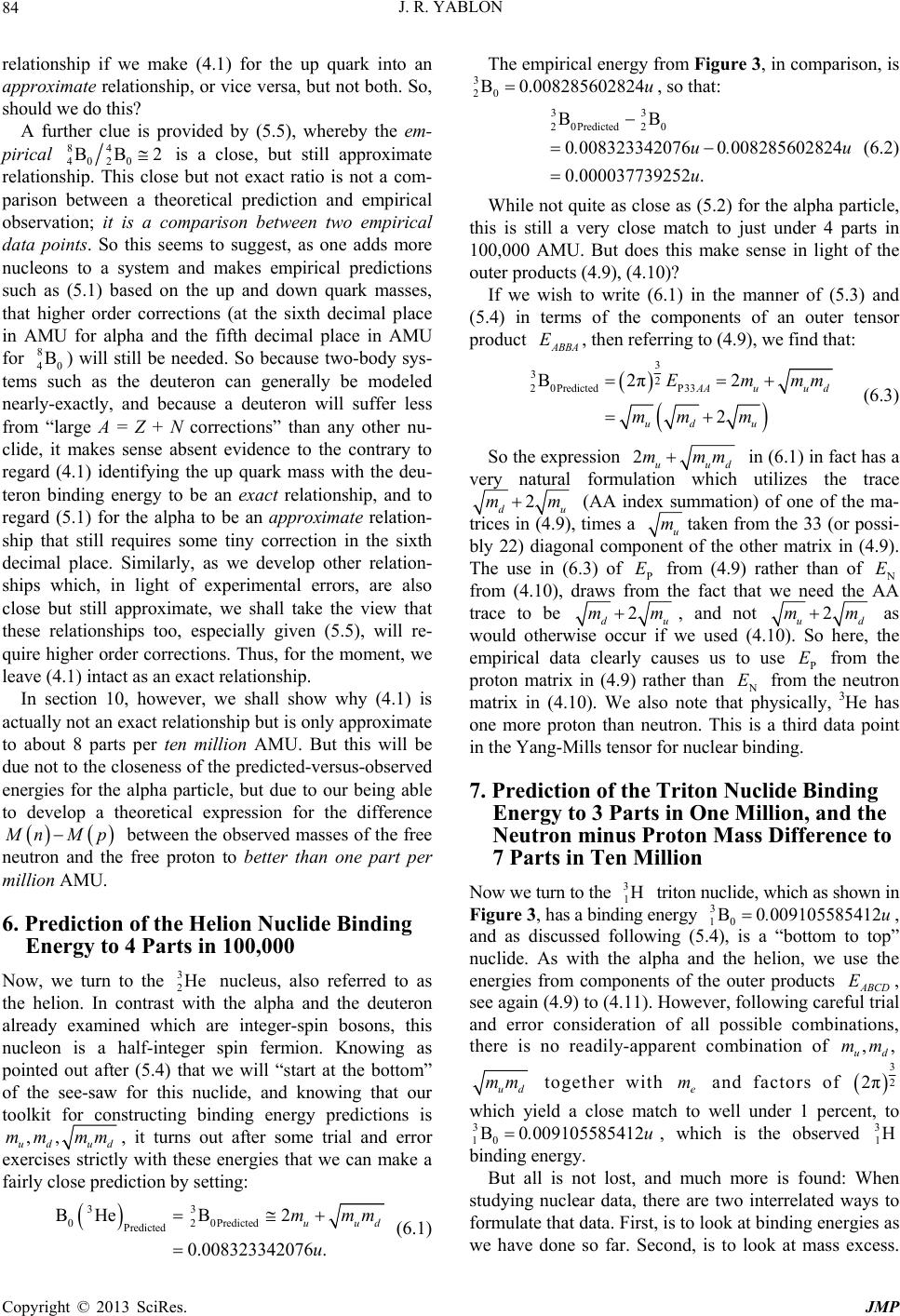 J. R. YABLON 84 relationship if we make (4.1) for the up quark into an approximate relationship, or vice versa, but not both. So, should we do this? A further clue is provided by (5.5), whereby the em- pirical 84 0 BB2 is a close but not exact rat al place n can ge near gard (4.1) identifying the up quark mass with the deu- teron binding energy to be an exact relationship, and to regard (5.1) for the alpha to be an approximate relation- ship that still requires some tiny correction in the sixth decimal place. Similarly, as we develop other relation- ships which, in light of experimental errors, are also close but still approximate, we shall take the view that these relationships too, especially given (5.5), will re- quire higher order corrections. Thus, for the moment, we leave (4.1) intact as In section 10, however, we shall show why (4.1) is not an exact relationship but is only approximate to about 8 parts per ten million AMU. But this will be due not to the closeness of the predicted-versus-observed energies for the alpha particle, but due to our being able to develop a theoretical expression for the difference 402, but still approximate relationship. This close io is not a com- parison between a theoretical prediction and empirical observation; it is a comparison between two empirical data points. So this seems to suggest, as one adds more nucleons to a system and makes empirical predictions such as (5.1) based on the up and down quark masses, that higher order corrections (at the sixth decim in AMU for alpha and the fifth decimal place in AMU for 8 40 B) will still be needed. So because two-body sys- tems such as the deuteronerally be modeled ly-exactly, and because a deuteron will suffer less from “large A = Z + N corrections” than any other nu- clide, it makes sense absent evidence to the contrary to re an exact relationship. actually M nMp between the observed masses of the free utron and tnehe free proton to better than one part per million AMU. 6. Prediction of the Helion Nuclide Binding Energy to 4 Parts in 100,000 Now, we turn to the 3 2He nucleus, also referred to as the helion. In contrast with the alpha and the deuteron already examined which are integer-spin bosons, this nucleon is a half-integer spin fermion. Knowing as pointed out after (5.4) that we will “start at the bottom” of the see-saw for this nuclide, and knowing that our toolkit for constructing binding energy predictions is ,, ud ud mm mm, it turns out after some trial and error exercises strictly with these energies that we can make a fairlose prediction by setting: The empirical energy from Figure 3, in comparison, is 3 20 B 0.008285602824u, so that: 33 2 0Predicted2 0 BB 602824 0.000037739252 .u (6.2) While not quite as close as (5.2) for the alpha particle, this is still a very clos 00083233420760 008285.u.u tch to just under 4 parts in 10 n ABBA , then referring to (4.9), we find that: e ma 0,000 AMU. But does this make sense in light of the outer products (4.9), (4.10)? If we wish to write (6.1) in the manner of (5.3) ad (5.4) in terms of the components of an outer tensor product E 3 32 2 0PredictedP33 B2π2 2 AA u Em mm m So the expression u d mm (6.3) ud u 2uud mmm in (6.1) in fact has a very natural formulation which utilizes the trace 2 du mm (AA index summation) of one of the ma- trices in (4.9), times a u mtaken from the 33 (or possi- bly 22) diagonal component of the other matrix in (4.9). The use in (6.3) of P E from (4.9) rather than of N E from (4.10), draws from the fact that we need the AA trace to be 2 du mm, and not 2 ud mm as would otherwise occur if we used (4.10). Shere, the empirical data clearly causes us to use P Eom the from the neutron matrix in (4.10). We also note that physically, 3He has one more proton than neutron. This is a third data point in the Yang-Mills tensor for nuclear binding. 7. Prediction of the Triton Nuclide Binding Energy to 3 Parts in One Million, and the Neutron minus Proton Mass Difference to o fr proton matrix in (4.9) rather than N E 7 Parts in Ten Million Now we turn to the 3 1H triton nuclide, which as shown in Figure 3, has a binding energy 3 10 B0 009105585412.u, and as discussed following (5.4), is a “bottom to top” nuclide. As with the alpha and the helion, we use the energies from components of the outer products ABCD E, see again (4.9) to (4.11). However, following careful trial and error consideration of all possible combinations, there is no readily-apparent combination of ,, ud mm ud mm together with e m and factors of 3 2 2π which yield a close match to well under 3 1 percent, to B 10 0 009105585412.u, which is the observed 3 1H binding energy. But all is not lost, and much more is found: When studying nuclear data, there are two interrelated ways to formulate that data. First, is to look at binding energies as we have done so far. Second, is to look at mass excess. y cl 33 02 0Predicted Predicted BHeB 2 0.008323342076 . uud mmm u (6.1) Copyright © 2013 SciRes. JMP 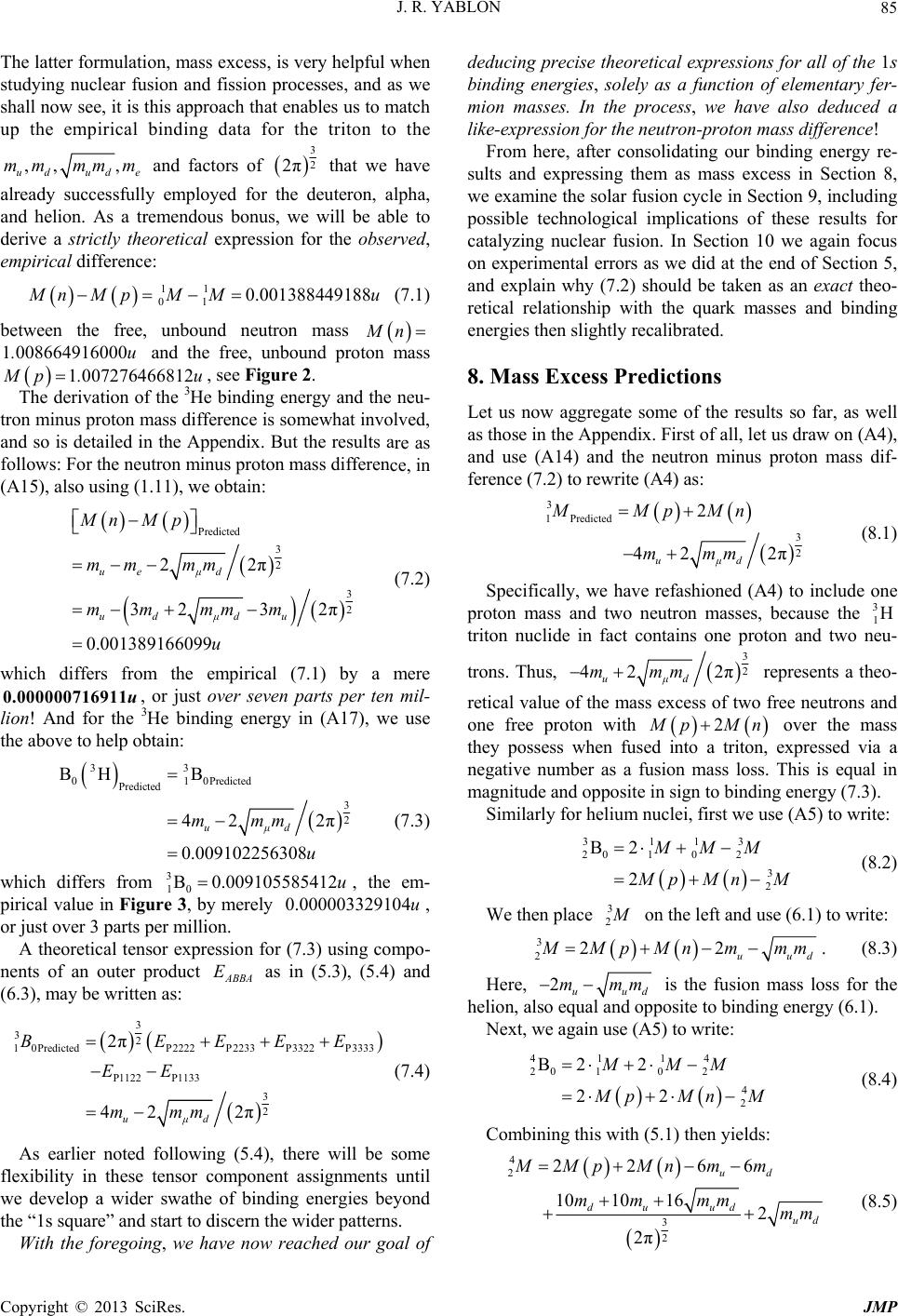 J. R. YABLON 85 The latter form ach that enables us to match up the empirical binding data for the triton to the ulation, mass excess, is very helpful when studying nuclear fusion and fission processes, and as we shall now see, it is this appro ,, , dud e mmmmm and factors of u 3 2 2π that we have ployedalready successfully em for the deuteron, alpha, and helion. As a tremendous bonus, we will be able to derive a strictly theoretical expression for the observed, empirical difference: 11 010.001388449 188 M nMpM Mu (7.1) between the free, unbound neutron mass M n 1 008664916000.u and the free, unbound proton mass 1 007276466812 M p. u, see Figure 2. The derivation of the 3He binding energy and the neu- tron minus proton mass difference is somewhat involved, and so is detailed in the Appendix. But the results a follows: For the neutron minus proton mass differen (A15), also using (1.11), we obtain: re as ce, in Predicted 3 2 3 2 22π 3232π ue μd ud μdu MnM p mm mm mm mmm g energy in (A17), we use th 0.001389166099u which differs from the empirical (7.1) by a mere 0.000000716911u, or just over seven parts per ten mil- lion! And for the 3He bindin (7.2) e above to help obtain: 33 10Predicted Predicted BH B 0 3 2 42 2π 0.009102256308 uμd mmm u (7.3) whic 9105585412u, the em- pi A theoretic uct h differs from 3 10 B 0.00 e 3, by merrical value in Figur 0.000003329104u, or just over 3 parts per million. al tensor expression for (7.3) using compo- nents of an outer prodABBA E as in (5.3), (5.4) and (6.3), may be written as: ely 3 32 1 0PredictedP2233P3322 P1122P1133 3 2 2π 42 2π uμd BEEEE EE mmm (7.4) As earlier noted following (5.4), there will be some flexibility in these tensor component assignments until we develop a wider swathe of binding energ P2222 P3333 ies beyond f de bin mi e have also deduced a e n g l ct theo nding energies 8. Mass Excess Pred the “1s square” and start to discern the wider patterns. With the foregoing, we have now reached our goal o ducing precise theoretical expressions for all of the 1s ding energies, solely as a function of elementary fer- on masses. In the process, w like-expression for theutron-proton mass difference! From here, after consolidatin our binding energy re- sults and expressing them as mass excess in Section 8, we examine the solar fusion cycle in Section 9, including possible technological implications of these resuts for catalyzing nuclear fusion. In Section 10 we again focus on experimental errors as we did at the end of Section 5, and explain why (7.2) should be taken as an exa - retical relationship with the quark masses and bi then slightly recalibrated. ictions Let us now aggregate some of the results so far, as well as those in the Appendix. First of all, let us draw on (A4), and use (A14) and the neutron minus proton mass dif- ference (7.2) to rewrite (A4) as: 3 1 Predicted 3 2 2 42 2π uμd MMpMn mmm (8.1) Specifically, we have refashioned (A4) to include one proton mass and two neutron masses, because the 3 1H triton nuclide in fact contains one proton and two neu- trons. Thus, 3 2 42 2π uμd mmm represents a theo- retical value of the mass excess of two free neutrons and one free proton with 2 M pMn over the mass they possess when fused into a triton, expressed equal in Similarly for heliu via a negative number as a fusion mass loss. This is magnitude and opposite in sign to binding energy (7.3). m nuclei, first we use (A5) to write: 3113 201 0 2 3 2 B2 2 MMM M pMnM (8.2) We then place 3 2 M on the left and use (6.1) to write: 3 222 uud M Mp Mnmmm. (8.3) Here, 2uud mmm is the fusion mass loss for the helion, also equal and opposite to binding energy (6.1). Next, we again use (A5) to write: 4114 2010 2 4 2 B22 22 MMM M pMnM (8.4) Combining this with (5.1) then yields: 4 22266 10 10 ud du MMpMnmm mm 3 2 16 2 2π ud ud mm mm (8.5) Copyright © 2013 SciRes. JMP  J. R. YABLON Copyright © 20 JMP 86 The fusion mass loss for the alpha—much larger than for the other nuclides we have examined—is given by the lengthie 22 13 SciRes. r terms after M pMn. Agai equaha binding energy with terms consolidated above. via (A5), it is easy to n, this is in (5.1), l and opposite to the alp Finally, from (4.1),deduce for the deuteron, that: 2 1u M Mp Mnm, (8.6) etical Review of the pr mine that an energy (A11) is released in this fusion, which energy, in light of (A13), now becom 9. A Theor Solar Fusion Cycle, and a Possible Approach to Catalyzing Fusion Energy Release As a practical exercise, let us now use all of the forego- ing results to theoretically examine the solar fusion cycle. The first step in this cycle is (A10) for the fusion of two otons into a deuteron. It is from (A10) that we deter- with a mass loss represented simply by u m, again, equal and opposite the bindingy (4.1). es: energ 3 2 2π0 01141003 d m.u (9.1) 11 2 11 1 Energy HHHEnergy20045 μ em This equates to 0.420235 MeV which is a well-k energy in solar fusion as is noted in the Appendix. The positron annihilates with an electron ee nown to pr where in deuterons produced in (9.1) fuse with pr prelions. We wri 2 otons to oduce hte this in terms of masses as: 321 11 Energy M M 1 M. (9.3) The proton mass is 1 oduce an additional e m2 worth of energy as well. The second reaction in the solar fusion cycle is: 21 3 11 2 HH HeEnergy (9.2) M , and these other two masses have already been found, respectively, i Thus, (9.3) may be reduced to: n (8.6) and (8.3). 21 3 11 2 EnergyHHHe Energy which equates to 5.528577 MeV, also a well-known en- ergy in the study of solar fusion. The final step in this cycle fuses two helions together 0 005935171976 ud mm. u u m (9.4) to of this relationship is as follows: 33411 22211 Energy The mass equivalent M MMMM (9.6) yield alpha particles plus protons, which protons then are available to repeat the cycle starting at (9.1): 33 411 22 211 HeHeHeHH Energy (9.5) Here we again make use of 1 1 M Mp, together with (8.3) and (8.5) to write: 3 2 41010 162π dudd u mmm mmm 33 411 22 211 EnergyHeHeHeHHEnergy2 0 0137 u m . This equates to 12.791768 Me 6 3252 ud m (9.7) V, which is also a well-known energy from solar fusion studies. g. [14]), the reaction he two 3He which 8003u Now, as is well known (see, e. (9.4) must occur twice to produce t2 are input to (9.7), and the reaction (9.1) must occur twice to produce the two 2 1H which are in turn input to (9.4). So pulling this all together from (9.1), (9.4), (9.7) and ee , we may express the entire solar fusion . In the top line b detail each energy release from large ions each contribution shown in the top line, including the neutrino - sol inate the cycle in (9.8) belowelow, we show in st to smallest, fol- lowed by the electron and neutrino emiss. In the second line we segregate in separate parenthesis, mass which is virtually zero. In the third line, we con idate terms. In the final line we use (1.11) to elim electron rest mass: 14 12 Energy4H2He12.79 M2 3 2 264 2π 1010 12 du ud ud ud du u mm mm mmm 3 2 MeV 20.42MeV 42 2224 2 2π μd u ude d mm m mmmm 3 2 10 10 16 4642 2π 222 ude ud ee mm mm m mmm mm m eV2 5.5 462 d ud ud mm mm 3 2 733389 MeV 2π uud . 12 26 mmm (9.8)  J. R. YABLON 87 The above shows at least two things. First, the total energy of approximately 26.73 MeV leased during solar fusion is expresse ed! This portends the ability to do the same for other types of fusion and fission, once the analysis of this paper is ex- nded to larger nuclides Z > 2, N > 2. ons as resonant cavities w more practical, because (9.8) tells us the precise that go into releasing the total 26.73 MeV of energy in the above. In particular, if one wanted to create an artifi- cial “sun in a box,” one would be inclined to amass a store of hydrogen, and subject that hydrogen store to g h In the above, we have explicitly sho fre ap h. So, what do we learn? If the nucleons are regarded as resonant cavities and the ener pend on the masses of their current quarks as is made ve and harmonics highlighted in (9.9) and (9.10 for harmonic fusion is to subject a hydroge high-fre proximate of with the v ill catalyze fusion by perhaps reducing the amount of heat that is required. In pre- sent-day approaches, fusion reactions are trigge heat generated from a fission reaction, and would be to reduce or eliminate this need for such high as, but not limited to, Compton backscattering and any other methods which are known at present or may become known in the future for pro- ducing gamma radiation, it would also be necessary to provide substantial shielding against the health effects of such radiation. The highest energy/smallest wavelength component, 629 44MeV6 69F d m. . known to be re- d entirely in terms of a theoretical combination of the up and down (and optionally electron) masses, with nothing else add te Secondly, because the results throughout this paper seem to validate modeling nucle ith energies released or retained based on the masses of their quark contents, this tells us how to catalyze “reso- nant fusion” which may make fusion technology resonances amma radiation at or near the specified discrete ener- gies that appear in (9.8), so as to facilitate resonant cav- ity vibrations at or near the energies required for fusion to occur. Specifically, one would bathe theydrogen store with gamma radiation at one or more of the follow- ing energies/frequencies in combination, some without, and some with, the Gaussian 3 2 2π divisor (we con- ths via vert to waveleng 1F1197 MeV): harmonic13 22 MeV14 91F ud mm . . 62944MeV669F 2 22MeV8856F 2harmonic4 45MeV44 28F 4harmonic8 90MeV22 14F 330MeV 5962F 2harmonic6 61MeV29 81F d u u u ud ud m. . m. . m.. m.. mm .. mm. . (9.9) 4 3 2 3 2 3 2 3 2 22π0.62 MeV316.15F 10 2π312MeV 6323F 10 2π141MeV139.47F 22 2π3.10 MeV63.40F d d u u m m. . m. m 3 2 3 2 3 2 3 2 22π0.42 MeV469 53F 42πharmonic0.84 MeV234.77F 12 2πharmonic2.52 MeV78 26F 16 2πharmon ud ud ud ud mm . mm mm . mm ic3.36 MeV58.69F (9.10) wn each basic quency/energy whichpears in the second, third or fourth lines of (9.8) as well as harmonics that appear in (9.8). Also, one should consider frequencies based on the electron mass and its wavelengt gies at which they fuse de- ry evident by (9.8), and given the particular energies ), the idea n store to quency gamma radiation at least one the frequencies (9.9), (9.10), iew that these harmonic oscillations w red using one goal heat and especially the need for any fissile trigger. That is, we at least posit the possibility—subject of course to laboratory testing to confirm feasibility—that applying the harmonics (9.9), (9.10) to a hydrogen store can cata- lyze fusion better than known methods, with less heat and ideally little or no fission trigger required. Of course, these energies in (9.9), (9.10) are very high, and aside from the need to produce this radiation via known methods such , is e energetic and would be very difficult to shield (and to produce), but this resonance arises from (9.8) which is for the final 33 411 22 211 HeHeHeHH Energy por- tion of the solar fusion cycle. If one were to forego this portion of the fusion cycle and focus only on catalyzing 112 xtremely 11 1 HH HEnergye to fuse protons into deuterons, then the only needed resonance is 3 2 22π0.42MeV469 53F ud mm .. Not only is this easiest to produce because its energy is the lowest of all the harmonics in (9.9) and (9.10), but it is the easiest to shield and the least harmful to humans. Certainly, a safe, reliable and effective method and associated hardware for producing energy via fusing protons into deuterons via reac(9.1), and perhaps tion nd deuterons intolions as in one of the haonics (9.9), (9.10) into a hydrogen store perhaps in combination with other known fusion methods, while insufficient to create the “artificial sun” modeled above if one foregoes the further fusing protons a he (9.4), by introducing at leastrm Copyright © 2013 SciRes. JMP 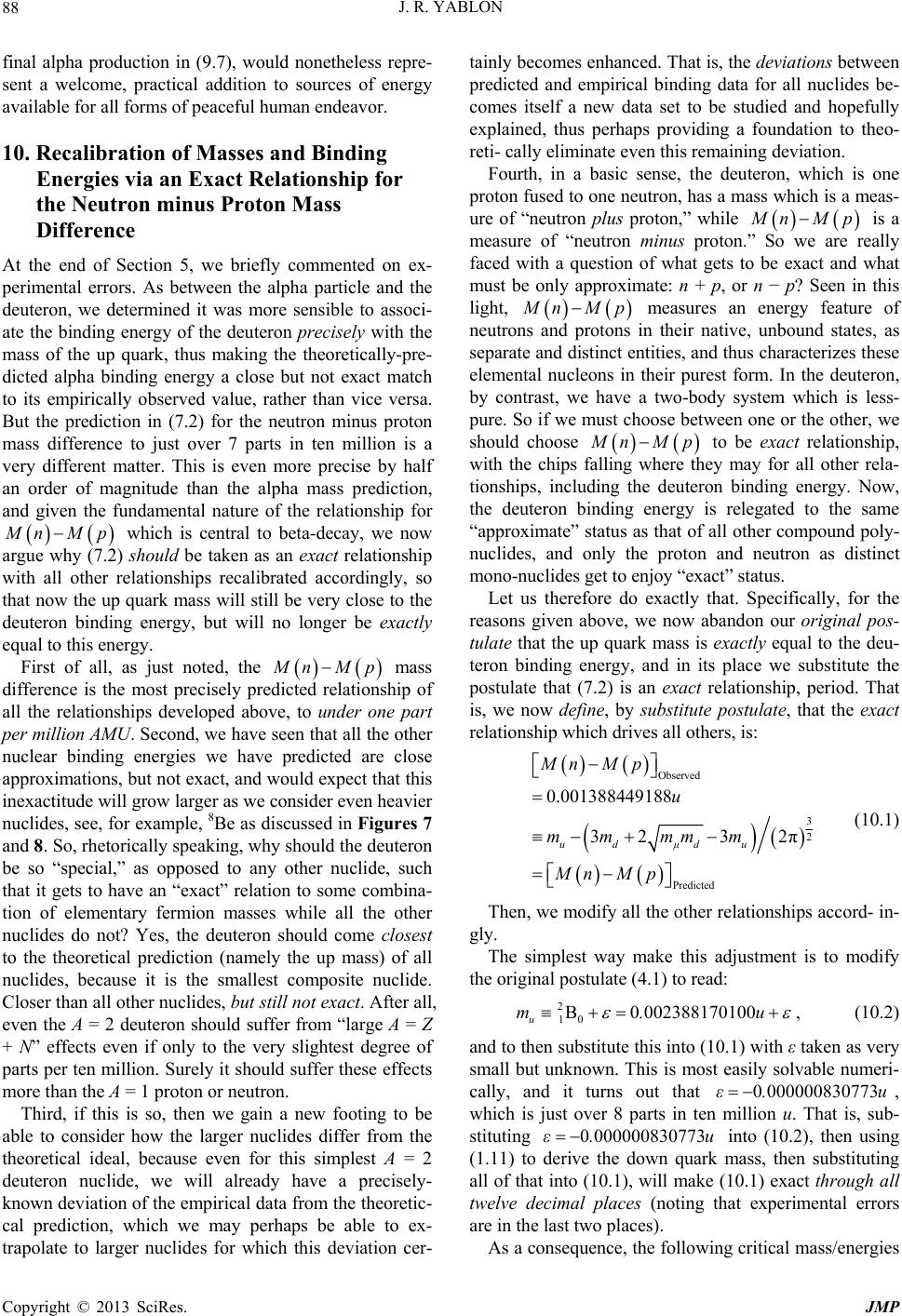 J. R. YABLON 88 final alpha production in (9.7), would nonetheless repre- sent a welcome, practical addition to sources of energy available for all forms of peaceful human endeavor. 10. Recalibration of Masses and Binding Energies via an Exact Relation the Neutron minus Proton Mass Difference At the end of Section 5, we briefly commented on ex- perimental errors. As between the alpha particle and the deuteron, we determined it was more sensible to associ- ate the binding energy of the deuteron precisely with the mass of the up quark, thus making the theoretically-pre- dicted alpha binding energy a close but not exact match to its empirically observed value, rather than vice versa. But the prediction in (7.2) for the neutron minus proton mass difference to just over 7 parts in ten million is a very different matter. This is even more precise by half an order of magnitude than the alpha mass pred and given the fundamental nature of the relationship for ship for iction, M nMp which is central to beta-decay, we now argue why (7.2) should be taken as an exact relationship with all other relationships recalibrated accordingly, so that now the up quark mass will still be very close to the deuteron binding energy, but will no longer be exactly equal to this energy. First of all, as just noted, the M nMp mass difference is the most precisely predicted relationship of all the relationships developed above, to under one part per million AMU. Second, we have seen that all the other nuclear binding energies we have predicted are close ap a precisely- kn a basic sense, the deutero proximations, but not exact, and would expect that this inexactitude will grow larger as we consider even heavier nuclides, see, for example, 8Be as discussed in Figures 7 and 8. So, rhetorically speaking, why should the deuteron be so “special,” as opposed to any other nuclide, such that it gets to have an “exact” relation to some combina- tion of elementary fermion masses while all the other nuclides do not? Yes, the deuteron should come closest to the theoretical prediction (namely the up mass) of all nuclides, because it is the smallest composite nuclide. Closer than all other nuclides, but still not exact. After all, even the A = 2 deuteron should suffer from “large A = Z + N” effects even if only to the very slightest degree of parts per ten million. Surely it should suffer these effects more than the A = 1 proton or neutron. Third, if this is so, then we gain a new footing to be able to consider how the larger nuclides differ from the theoretical ideal, because even for this simplest A = 2 deuteron nuclide, we will already have own deviation of the empirical data from the theoretic- cal prediction, which we may perhaps be able to ex- trapolate to larger nuclides for which this deviation cer- tainly becomes enhanced. That is, the deviations between predicted and empirical binding data for all nuclides be- comes itself a new data set to be studied and hopefully explained, thus perhaps providing a foundation to theo- reti- cally eliminate even this remaining deviation. Fourth, inn, which is one proton fused to one neutron, has a mass which is a meas- ure of “neutron plus proton,” while M nMp is a measure of “really faced with a question of what gets to be exact and what must be only approximate: n + p, or n − p? Seen in this neutron minus proton.” So we are light, M nMp measures d states, as separate and distinct entities, and thus characterizes these elemental nucleons in their purest form. In the uteron, by contrast, we have a two-body system whic- pu an energy feature of neutrons and protons in their native, unboun de h is less re. So if we must choose between one or the other, we should choose M nMp to be exact relationship, with the chips falling where they may for all other rela- tio act relationship which drives all others, is: nships, including the deuteron binding energy. Now, the deuteron binding energy is relegated to the same “approximate” status as that of all other compound poly- nuclides, and only the proton and neutron as distinct mono-nuclides get to enjoy “exact” status. Let us therefore do exactly that. Specifically, for the reasons given above, we now abandon our original pos- tulate that the up quark mass is exactly equal to the deu- teron binding energy, and in its place we substitute the postulate that (7.2) is an exact relationship, period. That is, we now define, by substitute postulate, that the ex Predicted Mn M p Then, we modify all the other relationships accord- in- gly. The simplest way make this adjustment is to modify the original postulate (4.1) to read: 2 10 B0 002388170100 u m.u Observed 3 0.001388449188 3 u MnM p u mm 2 23 2π dμdu mmm (10.1) , (10.2) and to then substitute this into (10.1) with ε taken as very small but unknown. This is most easily solvable numeri- cally, and it turns out that 0 000000830773ε.u , which is just over 8 parts in ten million u. That is, sub- 0 000000830773.u stituting ε the following critical mass/energies into (10.2), then using (1.11) to derive the down quark mass, then substituting all of that into (10.1), will make (10.1) exact through all twelve decimal places (noting that experimental errors are in the last two places). As a consequence, Copyright © 2013 SciRes. JMP  J. R. YABLON 89 de adjusted starveloped earlier become nominallyting at the sixth decimal place in AMU, and now become (con- trast (4.1), (4.3), (4.4), (4.5) and (4.6) respectively): 0 002387339327 u m. u, (10.3) 0 005267312526 d m. u, (10.4) 0 003546105236 ud mm .u, (10.5) 3 2 P2442π 0 008200606481 ud dudu Bmmmmmm .u (10.6) 3 2 N2442π 0 010531999771 du uudd Bmmmmmm .u (10.7) Additionally, this will slightly alter the binding ener- gies that were predicted earlier. The new results are as follows (contrast (5.1), (6.1) and (7.3) respectively): 4 2 0Predicted B0 030373002032.u, (10.8) 0 less than one 3 2 0Predicted B0 008320783890.u. (10.9) 3 1 0Predicted B0 009099047078.u. (10.10) and, via (10.3) and this adjustment of masses, 2 1 0Predicted B0002387339327 u m. u. (10.11) In (10.11), we continue to regard the predicted deu- teron binding energy 2 1 0Predicted B to be equal to the mass of the up quark, but because the mass of the up quark has now been slightly changed because of our substitute postulate, the observed energy, which is 2 10 B .002388170100u, will no longer be exactly equal to the predicted energy (10.11). Rather, we will now have 22 10 10Predicted BB, with a difference of part per million AMU. The precise, theoretical exactitude now belongs to the M nMp difference in (10.1). As a bonus, the up and down quark masses now become knowncision in AMU, with experimental errors in the 11th and 12th digits, which is inherited from the precision with which the electron, proton and neutron masses are known. One other point is very much worth noting. With an entirely theoretical, exact expression now developed for the neutron mins difference via (10.1), we start to target the full, dressed proton and neutron masses themselves. Specifically, it would be extremely desirable to be able to specify the proton and neutron masses as a function of the elementary up, down, and electron fer- mion masses, as we have here with binding energies. Fundamentally, by elementary algebraic p to ten-digit pre us proton mas rinciples, tak- in rst time, we now have an exact theoretical expression for the difference between these masses. But we still lack an independent expression related to their sum. Every effort should now be undertaken to fi relationship related to the sum of these masses. In all likelihood, that relationship, which must inherently ex- plain the natural ratio just shy of 1840 between the m of about 420 and 190 involving the up and down m those terms which involve the vacuum g each of the proton and neutron masses as an un- known, we can deduce these masses if we have can find two independent equations, one of which contains an exact expression related to the sum of these masses, and the other which contains an exact expression related to the difference of these masses. Equation (10.1) achieves the first half of this objective: for the fi nd another asses of the nucleons and the electron, and/or similar ratios asses, will need to emerge from an examination of the amended t’Hooft Lagrangian terms in (3.10) which we have not yet explored, particularly . While analyzing olve differences. Wha - bers for result referenced for The mass loss (negative m Section 8 which was very amining the solar fusion cycle negative (positive) of what is s just considered the binding ener- gies and mass excess and nuclear reactions as we have done here is a very valuable exercise, the inherent limita- tion is that all of these analyses invt is needed to obtain the “second” of the desired two inde- pendent equations, are sums, not differences (Note: the author lays the GUT foundation for, and then tackles this very problem, in two separate papers published in this same special issue of JMP). 11. Summary and Conclusion Summarizing our results here, we now have the follow- ing theoretical predictions for the binding energies in Fig- ure 3, with isobar lines shown, and with equation num convenience: see Figure 9. ass excess) discussed in helpful to the exercise of ex- in Section 9, is simply the hown in Figure 9. Having M nMp mass difference, it is useful to also look at the difference between the 3He isobars, A = 3 in the above. Given that 3He is the stable nuclide and that 3H undergoes 3H and decay into 3He, we may calculate the predicted difference in bind ergies to be: ing en- 33 20 103 Predicted 2 2 BB2 1 2π uud mmm (11.1) 0.00077826318 The empirical difference −0.00081998 from the predicted difference by 0.000 helpful to contrast the above to (the n which represents the most elementary 9u 2588 u differs 041719399u. It is egative of) (10.1) decay of a neutron into a proton. Similar calculations may be carried out as between the isotopes and isotones in F The numerical values of these theoretica igure 9. l binding en- Copyright © 2013 SciRes. JMP  J. R. YABLON JMP 90 er w predict eachtry in Figure 10, we su Figure 11 sh d, every one o re ndent predictio sonant cavity Yang-Mills magnetic mono- poles with binding energies determined by their current quark masses, provides the strongest theoretical explana- tion to date of what baryons are, and of how prot neutrons confine their quarks and bind together into com- posite nuclides. The theory of nuclear binding first de- ve ing energy for the 2H deuteron most precisely of all, to just over 8 parts in ten million. These energies as well as the neutron minus proton mass difference do not appear to have ever before been theo- gies in Figure 9, in AMU, using the recalibrated (10.8) through (10.11), are noed to be: see Figure 10. These theoretical predictions should be carefully compared to the empirical values in Figure 3. Indeed, subtracting each entry in Figure 3 from en mmarize our results for all of the 1s nuclides in Figure 11. ows how much each predicted binding energy differs from observed empirical binding energies. As has been reviewef these predictions is accurate to under four parts in 100,000 AMU (3He has the largest difference). Specifically: we have now used the thesis that baryons are resonant cavity Yang-Mills magnetic monopoles with binding energies reflective of their current quark m tically explained with such accuracy, and each of the foregoing energy predictions is mutually-independent from all the others. So even if any one prediction is thought to be nothing more than coincidence, the odds against five indepe ns on the order of 1 part in 105 or better being mere coincidence exceed 1025 to 1. This is not mere coincidence! This leads to the conclusion that the underlying thesis that baryons generally, and neutrons and protons espe- cially, are re asses to predict the binding energies of the 4He alpha to under four parts in one million, of the 3He helion to under four parts in 100,000 and of the 3H triton to under seven parts in one million. Of special im- port, we have exactly related the neutron minus proton mass difference—which is central to beta decay—to the up and down quark masses. This in turn enables us via the substitute postulate of Section 10 to predict the bind- ons and loped in [1] and further amplified here, establishes a basis for finally “decoding” the abundance of known data regarding nuclear masses and binding energies, and by Figure 9. Binding energies A Z0 B of 1s nuclides (Theoretical, AMU). Figure 10. Binding energies o A Z0 Bf 1s nuclides (Predicted, AMU). g energies A Z0 B of 1s nuclides (AMU). Figure 11. Predicted minus observed bindin Copyright © 2013 SciRes. 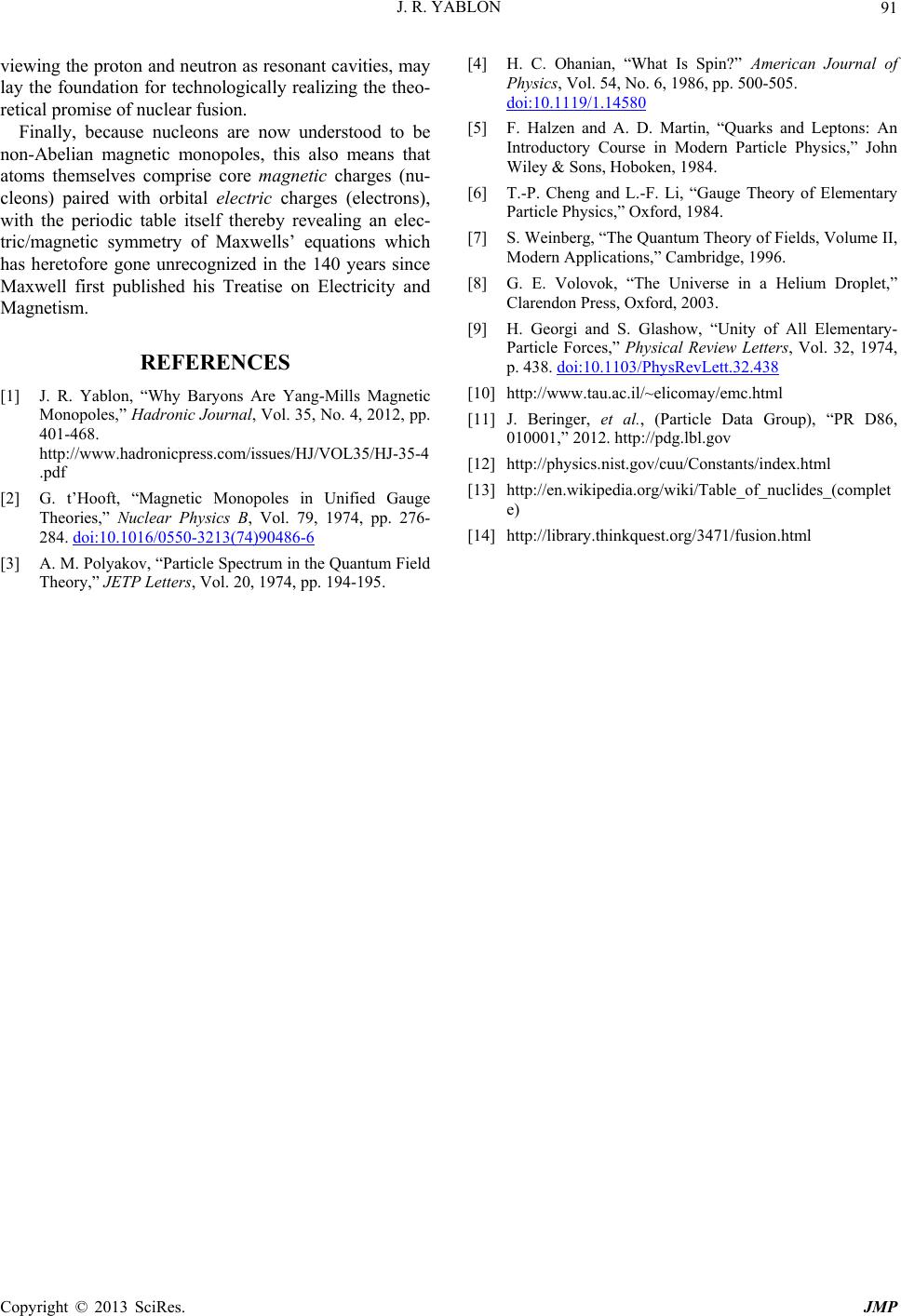 J. R. YABLON 91 agnetic charges (nu- cl has heretofore gone unrecognized in the 140 years since Maxwell first published his Treatise on Electricity and Magnetism. REFERENCES [1] J. R. Yablon, “Why Baryons Are Yang-Mills Magnetic Monopoles,” Hadronic Journal, Vol. 35, No. 4, 2012, pp. 401-468. http://www.hadronicpress.com/issues/HJ/VOL35/HJ-35-4 .pdf [2] G. t’Hooft, “Magnetic Monopoles in Unified Gauge Theories,” Nuclear Physics B, Vol. 79, 1974, pp. 276- 284. doi:10.1016/0550- viewing the proton and neutron as resonant cavities, may lay the foundation for technologically realizing the theo- retical promise of nuclear fusion. Finally, because nucleons are now understood to be non-Abelian magnetic monopoles, this also means that atoms themselves comprise core m eons) paired with orbital electric charges (electrons), with the periodic table itself thereby revealing an elec- tric/magnetic symmetry of Maxwells’ equations which 3213(74)90486-6 [4] H. C. Ohanian, “What Is Spin?” American Journal of Physics, Vol. 54, No. 6, 1986, pp. 500-505. doi:10.1119/1.14580 [5] F. Halzen and A. D. Martin, “Quarks and Leptons: An Introductory Course in Modern Particle Physics,” John Wiley & Sons, Hoboken, 1984. [6] T.-P. Cheng and L.-F. Li, “Gauge Theory of Elementary Particle Physics,” Oxford, 1984. [7] S. Weinberg, “The Quantum Theory of Fields, Volume II, Modern Applications,” Cambridge, 1996. [8] G. E. Volovok, “The Universe in a Helium Droplet,” Clarendon Press, Oxford, 2003. [9] H. Georgi and S. Glashow, “Unity of All Elementary- Particle Forces,” Physical Review Letters, Vol. 32, 1974, p. 438. doi:10.1103/PhysRevLett.32.438 [3] A. M. Polyakov, “Particle Spectrum in the Quantum Field Theory,” JETP Letters, Vol. 20, 1974, pp. 194-195. [10] http://www.tau.ac.il/~elicomay/emc.html [11] J. Beringer, et al., (Particle Data Group), “PR D86, 010001,” 2012. http://pdg.lbl.gov [12] http://physics.nist.gov/cuu/Constants/index.html [13] http://en.wikipedia.org/wiki/Table_of_nuclides_(complet e) 471/fusion.html [14] http://library.thinkquest.org/3 Copyright © 2013 SciRes. JMP 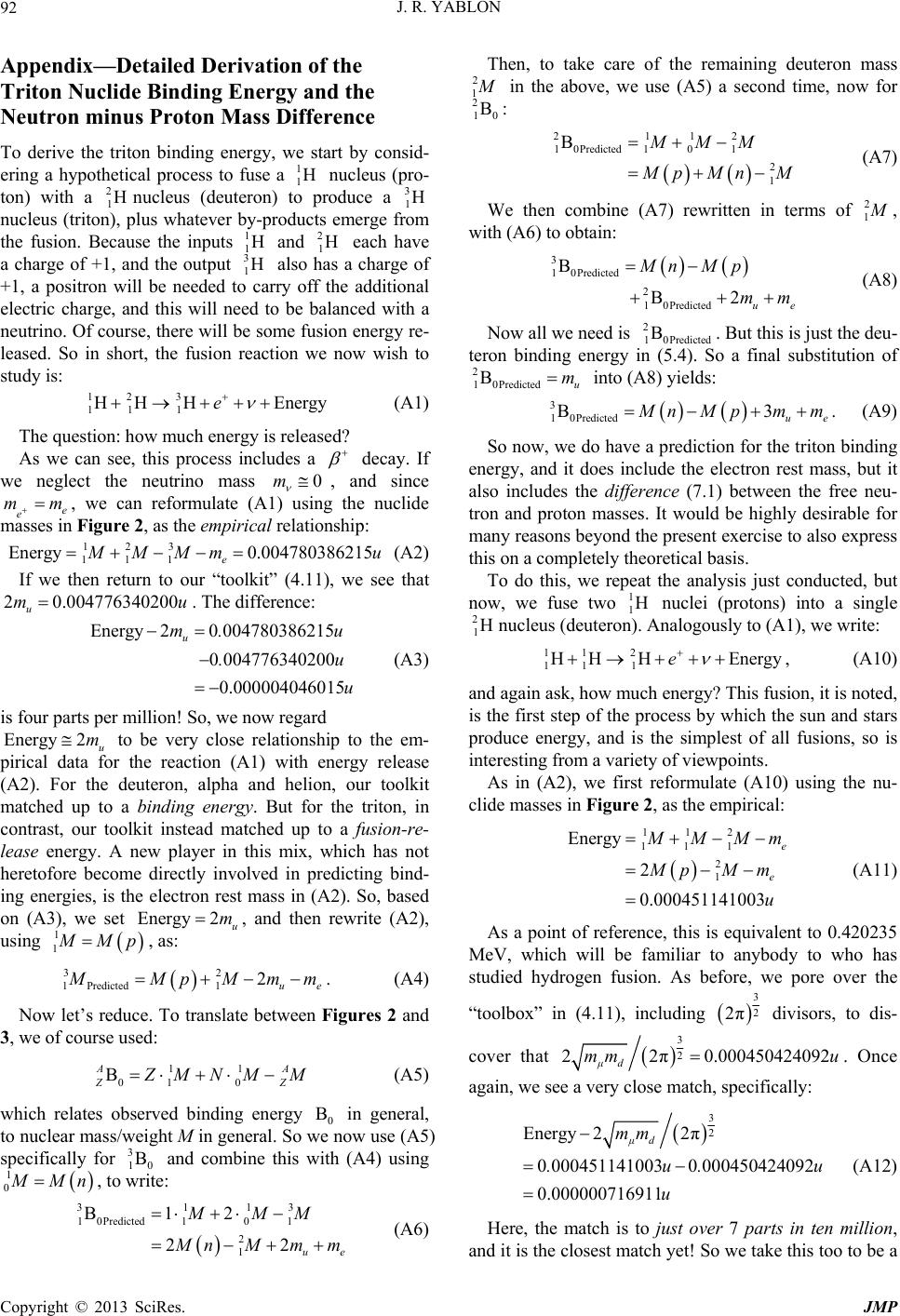 J. R. YABLON 92 Appendix—Detailed Derivation of the Triton Nuclide Binding Energy and the Neutron minus Proton Mass Difference To derive the triton binding energy, we start by consid- g a hypothetical process to fuserine a 1H nucleus (pro- ton) with a 2 1Hnucleus (deuteron) to produce a 3 1H leus (triton), plus whatever by-p 1 s a charge of to be balanced with a eutrino. Of course, there will be some fusion energy re- ased. So in short, the fusion reaction we now wish to udy is: Energy (A1) The question: how much energy is released? As we can see, this process icludes a nuc roducts emerge from the fusion. Because the inputs 1 1H and 2 1H each have a charge of +1, and the output 3H also ha 1 +1 , a positron will be needed to carry off the additional lectric charge, and this will neede n le st 123 11 1 HH He n decay. If e neglect the neutss 0m , and since e e, we can rA1) using the nuclide asses in Figure 2cal relationship: 4780386215 wrino eformu , as the ma late ( empiri mm m 123 111 Energy 0.00 e M MMm u (A2) If we then return to our “toolkit” (4.11), we see that 76340200mu. The difference: 80386215 6340200 004046015 u .u u (A3) four parts per million! So, we now regard ergy2 u m to be very close relationship to the em- irical data for the reaction (A1) with energy release 2). For the deuteron, alpha and helion, our toolkit atched up to a binding energy. But for the triton, in ontrast, our toolkit instead matched up to a fusion-re- ase energy. A new player in this mix, which has not eretofore become directly involved in predicting bind- g energies, is the electron rest mass in (A2). So, based nEnergy2 u m, and then rewrite (A2), 2 0.0047 u Energy20 0047 0 00477 0.000 u m. is En p (A m c le h in o (A3), we set ing 1 1 us M Mp, as: 32 1 Predicted12ue M MpMm m. Now let’s reduce. To translate between Figures 3, we of course used: (A4) 2 and 11 010 B AA ZZ Z MNM M (A5) which relates observed binding energy 0 B in gene, to nuclear mass/weight M in general. So we now use (A5) specifically for 3 10 B and combi this with (A4) using 1 0 Then, to take care of the remaining deuteron mass 2 1 M in the above, we use (A5) a second time, now for 2: 10 B 21 2 1 12 10Predicted1 0 1 BMMM M pMn (A7) M 2 We then combine (A7) rewritten in terms of 1 M , with (A6) to obtain: 3 1 0Predicted BMnM p 2 10Predicted B2 ue mm (A8) Now all we need is 2 1 0Predicted B. But this is just the deu- teron binding energy in (5.4). So a final substitution of 2 1 0Predicted Bu m into (A8) yields: 3 1 0Predicted B3 ue M nMp mm . (A9) So now, we do have a prediction for the triton binding energy, and it does include the electron rest mass, but it also includes the difference (7.1) between the free neu- tron and proton masses. It would be highly desirable for many reasons beyond the present exercise to also express this on a completely theoretical basis. To do this, we repeat the analysis just conducted, but now, we fuse two 1 1H nuclei (protons) into a single 2 1Hnucleus (deuteron). Analogously to (A1), we write: 11 2 11 1 HH HEnergye , (A10) and again ask, how much energy? This fusion, it is noted, is the first step of the process by which the sun and stars produce energy, and is the simplest of all fusions, so is interesting from a variety of viewpoints. As in (A2), we first reformulate (A10) using the nu- clide masses in Figure 2, as the empirical: 112 111 2 1 Energy 2 0.0004511410 03 e e M MMm M pMm u (A11) As a point of reference, this is equivalent to 0.420235 MeV, which will be familiar to anybody to who has studied hydrogen fusion. As before, we pore over the “toolbox” in (4.11), including 3 2 2π divisors, to dis- ral ne M Mn, to write: 3113 10Predicted 101 2 1 B12 22 ue MMM M nMmm (A6) cover that 3 2 22π0.00045042 μd mm ag 4092u. Once ain, we see a very close match, specifically: 3 2 Energy 22π 0 0004511410030 000450424092 0.000000716911 μd mm .u.u u (A12) an Here, the match is to just over 7 parts in ten million, d it is the closest match yet! So we take this too to be a Copyright © 2013 SciRes. JMP 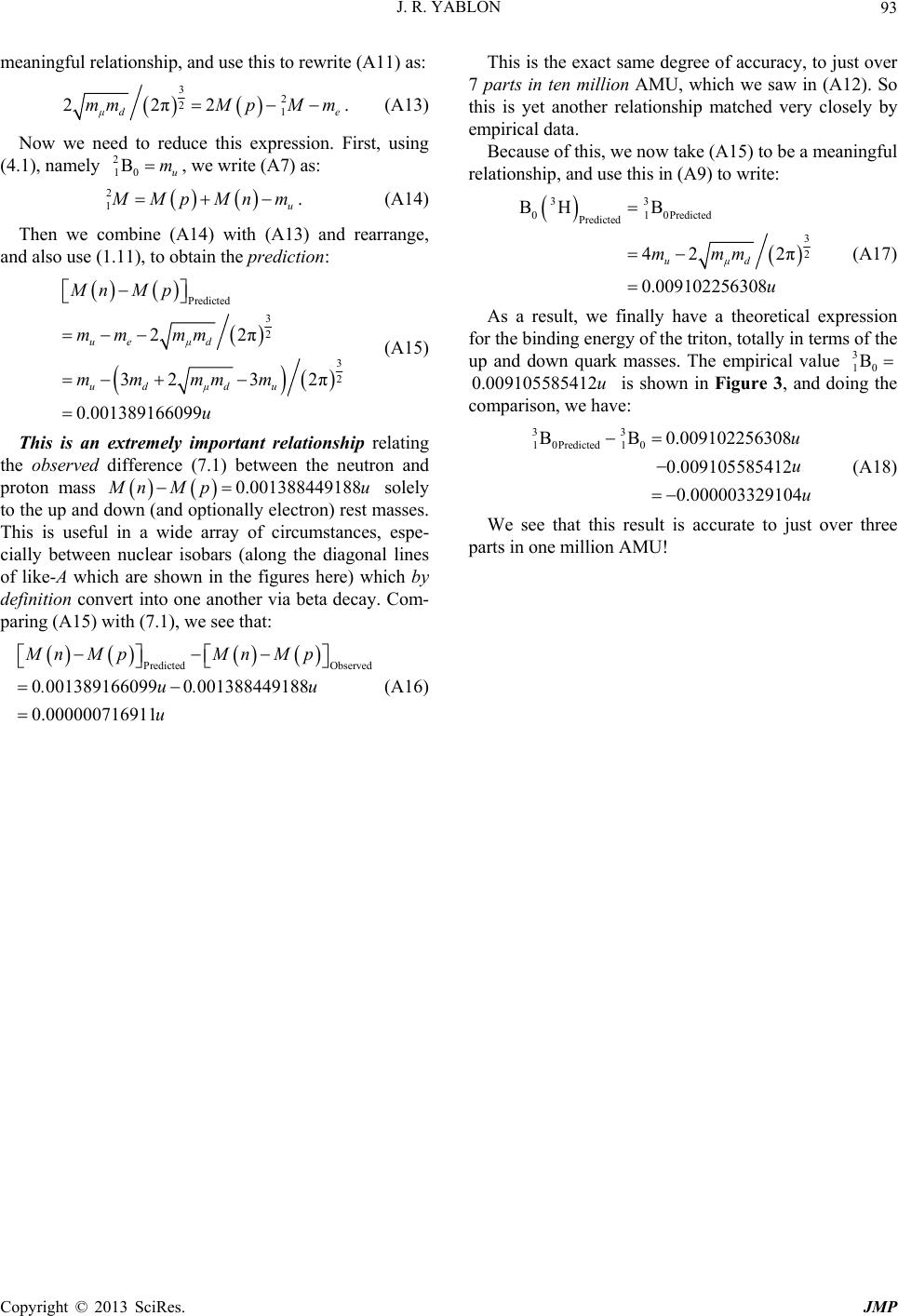 J. R. YABLON 93 meaningful relationship, rite (A11) as: and use this to rew 2 1e pM m. Now we need to reduce this expression. First, using 2 3 2 22π2 μd mm M (A13) (4.1), namely 10 Bu m, we write (A7) as: 2 1u M MpMn m. (A14) Then we combine (A14) with (A13) and rearrange, and also use (1.11), to obtain the prediction: Predicted 3 2 3 2 22π 33 2π 16609 ue μd uu MnM p mm mm mmm (A15) 2 0.001389 9 dμd mm u This is an extremely important relatio th nship relating e observed difference (7.1) between the neutron and proton mass 0.001388449188 M nMp u solely to the up and down (and optionally electron) rest masses. This is useful in a wide array of circu cially between nuclear isobars (along the diagonal lines he mstances, espe- of like-A which are shown in the figures re) which by definition convert into one another via beta decay. Com- paring (A15) with (7.1), we see that: Observed 9188 M p u A thisy empirical data. Because of this, we now take (A15) to b Predicted 0 0013891660990 00138844 0.000000716911 MnM pMn .u. u (A16) This is the exact same degree of accuracy, to just over 7 parts in ten millionMU, which we saw in (A12). So is yet another relationship matched very closely b e a meaningful relationship, and use this in (A9) to write: 33 010Predicted Predicted BH B 3 As a result, we finally have a theoretical expression for the binding energy of the triton, totally in term up and down quark masses. The empirica 2 42 2π 0.009102256308 uμd mmm u (A17) s of the l value 3 10 B 0.009105585412u is shown in Figure 3, and doing the co 00332 just ove illion AMU! mparison, we have: 33 1 0Predicted1 0 BB 0.009102256308 0.009105585 412 u u (A18) 0.000 9104u We see that this result is accurate to r three parts in one m Copyright © 2013 SciRes. JMP |

